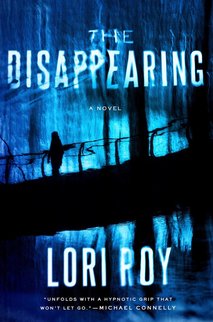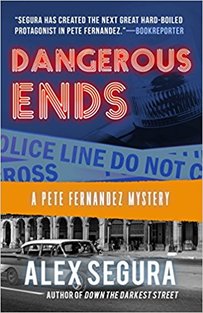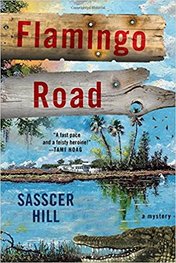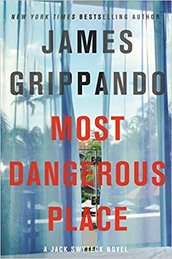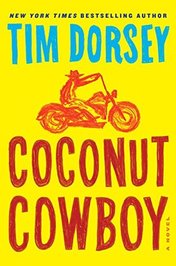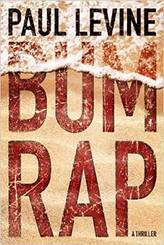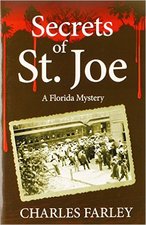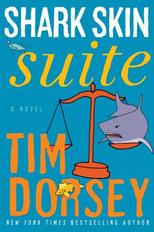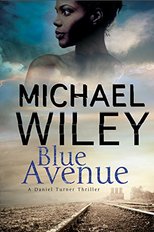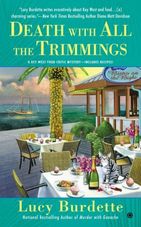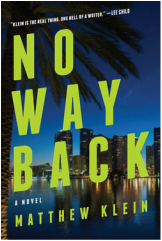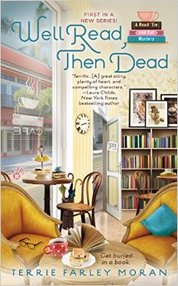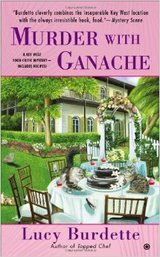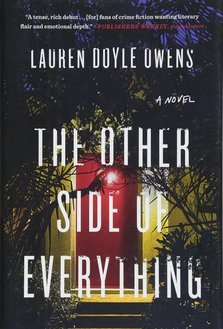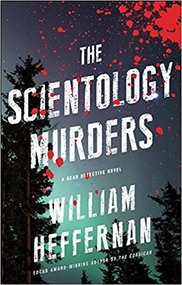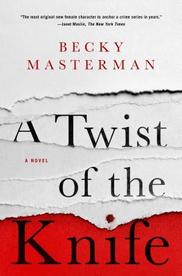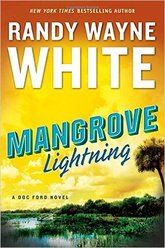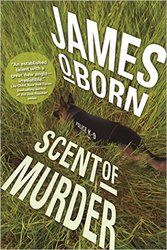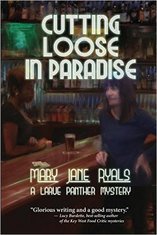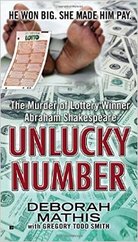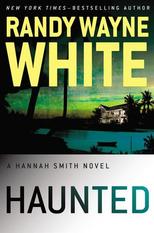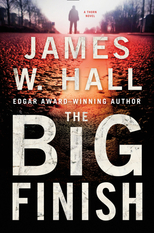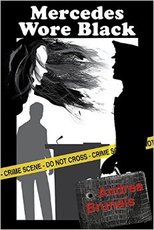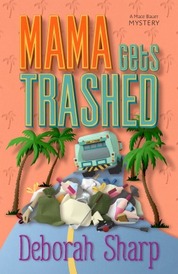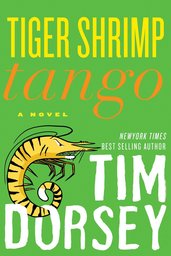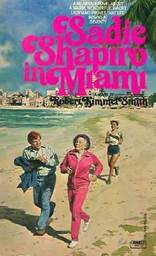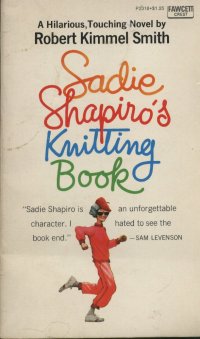Crime Writing
On this page:
◇ Tampa Bay Noir, edited by Colette Bancroft, reviewed by Pamela Akins
◇ The Disappearing by Lori Roy, reviewed by Ed Irvin
◇ The Other Side of Everything by Lauren Doyle Owens, reviewed by Victoria Calderin
◇ Dangerous Ends by Alex Segura, reviewed by Natalie Havlina
◇ The Scientology Murders by William Heffernan, reviewed by Jessica Dealing
◇ Lightwood by Steph Post, reviewed by Jessica Borsi
◇ A Twist of the Knife by Becky Masterman, reviewed by Natalie Havlina
◇ Flamingo Road by Sasscer Hill, reviewed by Jessica Borsi
◇ Mangrove Lightning by Randy Wayne White, reviewed by Jessica Dealing
◇ Most Dangerous Place by James Grippando, reviewed by Jessica Borsi
◇ Scent of Murder by James O. Born, reviewed by Ed Irvin
◇ Coconut Cowboy by Tim Dorsey, reviewed by Ed Irvin
◇ Cutting Loose in Paradise by Mary Jane Ryals, reviewed by Pamela Akins
◇ Bum Rap by Paul Levine, reviewed by Ed Irvin
◇ Unlucky Number by Deborah Mathis with Gregory Todd Smith, reviewed by Jason Ehlen
◇ Secrets of Saint Joe by Charles Farley, reviewed by Edward Hagelstein
◇ The Emperor's Club by Anthony Gagliano, reviewed by Pamela Akins
◇ Suitcase City by Sterling Watson, reviewed by Ed Irvin
◇ Haunted by Randy Wayne White, reviewed by Jason Ehlen
◇ Shark Skin Suite by Tim Dorsey, reviewed by Ed Irvin
◇ The Big Finish by James W. Hall, reviewed by Ed Irvin
◇ Blue Avenue by Michael Wiley, reviewed by Ed Irvin
◇ Mercedes Wore Black by Andrea Brunais, reviewed by Stephanie Selander
◇ Death with All the Trimmings by Lucy Burdette, reviewed by Ed Irvin
◇ Mama Gets Trashed by Deborah Sharp, reviewed by Jeffrey Fernandez
◇ No Way Back by Matthew Klein, reviewed by Ed Irvin
◇ Tiger Shrimp Tango by Tim Dorsey, reviewed by Ed Irvin
◇ Well Read, Then Dead by Terrie Farley Moran, reviewed by Ed Irvin
◇ Sadie Shapiro in Miami by Robert Kimmel Smith, a reconsideration by Dina Weinstein
◇ Murder with Ganache by Lucy Burdette, reviewed by Ed Irvin
◇ Tampa Bay Noir, edited by Colette Bancroft, reviewed by Pamela Akins
◇ The Disappearing by Lori Roy, reviewed by Ed Irvin
◇ The Other Side of Everything by Lauren Doyle Owens, reviewed by Victoria Calderin
◇ Dangerous Ends by Alex Segura, reviewed by Natalie Havlina
◇ The Scientology Murders by William Heffernan, reviewed by Jessica Dealing
◇ Lightwood by Steph Post, reviewed by Jessica Borsi
◇ A Twist of the Knife by Becky Masterman, reviewed by Natalie Havlina
◇ Flamingo Road by Sasscer Hill, reviewed by Jessica Borsi
◇ Mangrove Lightning by Randy Wayne White, reviewed by Jessica Dealing
◇ Most Dangerous Place by James Grippando, reviewed by Jessica Borsi
◇ Scent of Murder by James O. Born, reviewed by Ed Irvin
◇ Coconut Cowboy by Tim Dorsey, reviewed by Ed Irvin
◇ Cutting Loose in Paradise by Mary Jane Ryals, reviewed by Pamela Akins
◇ Bum Rap by Paul Levine, reviewed by Ed Irvin
◇ Unlucky Number by Deborah Mathis with Gregory Todd Smith, reviewed by Jason Ehlen
◇ Secrets of Saint Joe by Charles Farley, reviewed by Edward Hagelstein
◇ The Emperor's Club by Anthony Gagliano, reviewed by Pamela Akins
◇ Suitcase City by Sterling Watson, reviewed by Ed Irvin
◇ Haunted by Randy Wayne White, reviewed by Jason Ehlen
◇ Shark Skin Suite by Tim Dorsey, reviewed by Ed Irvin
◇ The Big Finish by James W. Hall, reviewed by Ed Irvin
◇ Blue Avenue by Michael Wiley, reviewed by Ed Irvin
◇ Mercedes Wore Black by Andrea Brunais, reviewed by Stephanie Selander
◇ Death with All the Trimmings by Lucy Burdette, reviewed by Ed Irvin
◇ Mama Gets Trashed by Deborah Sharp, reviewed by Jeffrey Fernandez
◇ No Way Back by Matthew Klein, reviewed by Ed Irvin
◇ Tiger Shrimp Tango by Tim Dorsey, reviewed by Ed Irvin
◇ Well Read, Then Dead by Terrie Farley Moran, reviewed by Ed Irvin
◇ Sadie Shapiro in Miami by Robert Kimmel Smith, a reconsideration by Dina Weinstein
◇ Murder with Ganache by Lucy Burdette, reviewed by Ed Irvin
|
The Disappearing by Lori Roy
(Dutton, Hardcover, 352 pp., $27) Reviewed by Ed Irvin Twenty years ago, Lane Fielding entered a marriage of convenience to escape small-town prattle and the sometimes sympathetic, often judgmental stares with which people view the victim of an abduction. In Lori Roy's The Disappearing, the now-divorced mother of two has returned to Waddell, Florida to find that small towns never forget and history has a way of repeating itself. Leaving behind a career in journalism and an unfaithful husband, Lane tends bar and manages the books at Rowland's, Waddell's local watering hole. She's moved into her family home, the historic Fielding Plantation, with her two daughters, Annalee, full of teen angst and rebellion, and Talley, a nine-year-old with a proclivity for allowing her curiosity to get her into trouble. Lane finds Waddell abuzz with reporters chasing a story that hits close to home. Lane's aged father, Neil Fielding, who once ran a now-shuttered boys’ reformatory school, is being accused of heinous acts by the school’s former residents. Although she doubts the validity of the men's claims, Lane knows what her father has been capable of. As a young girl, Lane would leave food in the field that separated the school from her family home, along with a note of warning for the boys who dared to attempt escape, telling them not to come onto Fielding Plantation property for fear of her father’s retribution if he caught them. When Lane disappeared one night for several hours, suspicions were naturally directed at the troubled boys. Despite Lane's denials that anything sexual had happened, the student who Neil Fielding suspected of taking his daughter and doing Lord-knows-what with her was never seen again. In the present, to make things worse, Susanna Butler, a student at Florida State University in nearby Tallahassee who has been volunteering at the Fielding Plantation and has befriended young Talley, vanishes. With this development, press attention goes national. When Annalee disappears days after Susanna, Lane finds herself drawn into the investigation, wondering if the town has decided she must atone for the sins of her father. Chapter by chapter, The Disappearing is told from the points of view of Lane, her mother, Talley, and Daryl, the odd and reclusive young man who does maintenance at the local church. Daryl's brother was once a resident of the boys' school, and Daryl has come to Waddell to find out what happened to him there. Like Susanna, Daryl has befriended Talley, who I found to be the driving voice behind this story. Perhaps it's her youthful naivete that allows Talley to witness the events of The Disappearing so purely that she has a better grip on what's going on and who is trustworthy than any of the other perspectives do. Maybe it's because she's always in the scene, being told to be quiet while the adults talk or to go get a snack while Mommy speaks to the policeman. Talley is wiser than her years, and even though the school for boys is closed, she wants to be like her mom and leave food for "the boys who run." If one of those runaway boys was new to the school, he might mistakenly run straight for Grandpa's land. This is why Mama would leave the food and a note too. Don't come this way, she would warn them in her notes. That's how brave Mama was when she was a girl, and how brave Talley hopes to be too. Talley once asked Mama straight out why at thirteen years old she stopped leaving the food. Did the boys not need it anymore? Did they stop running? Mama shook her head. They still ran, she said, but my food, my notes, couldn't save them. The Disappearing is my first taste of Lori Roy. Based on its quality, I'm not surprised she has previously won two Edgar awards. Her writing is reminiscent of the work of two of my favorites, Michael Koryta and John Hart.
This novel is Southern Gothic at its finest, featuring flawed characters you empathize with because Roy makes you understand their motivations as authentic, although misguided. Anyone who’s ever spent time in Florida swampland will appreciate Roy's rendering of place, from the loud hum of stinging insects, to the shade of majestic oak trees, the sweet honey produced by tupelo trees, and the cypress knees lurking just above and below the surface of black river water, posing a danger to boaters and waders alike. It made me nostalgic for the days when my mother would spread creamy pink Calamine lotion on mosquito bites I'd scratched until they bled. If it's fantastic fiction that soothes your itch, allow The Disappearing to find itself atop your reading list. Ed Irvin, a Florida Book Review Contributing Editor, lives and writes in Boynton Beach, FL. Dangerous Ends by Alex Segura
(Polis Books, Hardcover, 320 pp., $24.99) Review by Natalie Havlina Dangerous Ends is Alex Segura’s third novel featuring Pete Fernandez, a Miami-based reporter-turned private investigator. Pete “goes along for the ride” when his reporter friend Kathy Bentley is hired to write a book about Gaspar Varela, a former police officer serving a life sentence for the murder of his wife. Varela’s daughter, Maya, hopes that a fresh investigation will prove his innocence. Delving into the Varela case makes Pete and Kathy targets for a gang of pro-Castro drug dealers and leads Pete back to violent events in his own family’s history. The present offers unexpected twists and plenty of action (or, at least, plenty of shooting). Segura portrays Miami in impressive detail. He doesn’t only create atmosphere—“Miami was vibrant, as if propelled by the swamp-like heat”—he takes the reader on a driving tour of South Florida, sometimes describing locations so specifically that you could follow Segura’s directions yourself. Want to see where Pete interviews a homeless man? "Pete turned off South Bayshore Drive and parked down McFarland Road, near the street's dead-end finale on the fringe of Peacock Park." In addition to being mappable, every place in the story has its own personality. There’s Storage Extreme, where, “Pete wasn’t sure what, aside from the lack of care, was extreme about the place.” There’s Miami International Airport, which “could have been an honorary circle of hell” before the remodel, but now “felt almost like a modern airport.” From a private home with “tropical and tacky” interior decor to a beachside club whose “lighting had probably caused its fair share of brain aneurisms,” Segura made me feel like I was present for every single interview. I also enjoyed the snapshots Segura provided of the supporting characters. My favorite is radio personality Madelyn Suarez, a “short older woman with a bleached-blond bouffant hairstyle and a lime green business suit” who comes “storming out” of a recording studio, “cigarette dangling from her mouth, and what looked like a gallon-sized travel coffee mug in her hand.” Why then, given the book’s strengths, did I sometimes feel like I could set it down and not look back? For me, there was just a little too much of everything. As much as I enjoyed the book’s sense of place, driving with Pete to so many bars, restaurants, and quirky locales was tiring. Maybe points are due for verisimilitude—getting around Miami is energy intensive—but my eagerness to relive that experience on the page is limited. And when Segura brings in characters from his earlier books, like FBi agent Andrew Harras and Pete's ex-wife, Emily, series fans might enjoy hearing their histories again, but a first-time reader like me doesn't, for instance, need to know all the ups and downs of Pete and Emily's failed relationship to appreciate the significance of Emily's new husband, a low-level drug dealer, being murdered. Dangerous Ends is a well-constructed novel and its foundation is solid. Segura successfully ties together the diverse threads of the story, bringing a complex plot to a satisfying resolution. I think its strengths would shine through even more if some of the excess were pared away. Although Dangerous Ends wasn’t the ideal summer read for me, readers who have a pre-existing bond with Pete and Kathy will enjoy this book, as will fans of Miami noir who are eager to explore the city in abundant detail. Natalie Havlina is a teaching assistant in the MFA Program in Creative Writing at Florida International University and a Florida Book Review Contributing Editor. Prior to coming to FIU, Havlina spent a decade practicing public interest law in the Northwest. Lightwood by Steph Post
(Polis Books, Hardcover, 336 pp. $25.99) Reviewed by Jessica Borsi Steph Post’s second novel Lightwood explores blood ties and personal histories even in its very title which is drawn from “the stories of old women shelling peas on front porches.” Above all, it’s concerned with the strength of those blood ties, and how tradition can, sometimes literally, drag people into the wilds. Upon his release from prison for armed robbery, Judah Cannon finds that his sleepy, north Florida hometown hasn’t changed. The Cannons are still intimidating and stealing their way to a stable living, and the family’s ruthless patriarch Sherwood wants Judah back in the game for their largest score in years. But Judah, sobered from his three years in prison and recently reconnected with his old friend turned lover Ramey, isn’t eager to return to a life of crime until Sherwood uses their history to force him into it. Stealing from the Scorpions—local meth-cooking bikers—seems like easy money, but mixed in with their drug money is an investment from Sister Tulah, a fanatic who preaches salvation through abuse. And once she discovers who robbed her, she is prepared to baptize them all with fire until she gets what is hers. Post’s new Southern Gothic thriller has atmosphere with a capital A. Having grown up in rural north Florida myself, the small-town life in Lightwood feels real and familiar. I found her depictions of long, sticky days and local wildlife especially vivid. There’s a sense of doom, even in a placid moment when “a kestrel swooped down . . . crashed into the grass, sending up a spray of tiny winged creatures. The bird rose in discontent, its claws empty.” The fictional town of Silas, Florida is a place that “had ceased evolving back in the late 1960s . . . [it] would only be useful when the zombie apocalypse hit and the survivors needed an abandoned Save-A-Lot to loot.” The small-town veneer of mom-and-pop diners hides a desperate criminal underbelly and people unable to escape their roots. Lightwood employs nine narrators, the most dominant being Judah, Ramey, the biker Jack O’Lantern, and Sister Tulah. But with some narrators only having small sections, not all of them felt necessary, and the frequent point of view shifts sometimes worked against the story. Early on, Jack O’Lantern vows to make the Cannons pay for robbing him, but the more I was in Jack’s head the less intimidating he became. In addition, near the middle of the book Judah learns roughly the same information earlier presented by Jack. This is one of my favorite scenes in the book because Judah and Ramey encounter Hiram, a paranoid hermit who has populated his trailer with stuffed squirrels, one of which is “balanced on top of the television . . . dressed as a crusader,” but the repetition reduced tension where it should be heightening it. Judah and Ramey are a sort of Romeo and Juliet in a Bonnie and Clyde world, but the structure limited how much time the reader could spend with them. Despite receiving the most development, Judah’s internal struggle was sometimes overshadowed when, for instance, followed by a scene of Sister Tulah preaching hell and damnation while brandishing a mason jar filled with strychnine. The excellence of the atmosphere and the tension of the late going made me feel that Steph Post’s Lightwood could have been even more fascinating if it had concentrated on the most central characters. I look forward to seeing what Post does in the future. Jessica Borsi lives and writes both in Miami and on a farm in the Panhandle. She is an MFA student at Florida International University, and her lyric essay on science fiction can be found in So to Speak. Flamingo Road by Sasscer Hill
(Minotaur Books, Hardcover, 307 pp., $25.99) Reviewed by Jessica Borsi High stakes horse racing meets police procedural in Sasscer Hill’s newest thriller, Flamingo Road. After being suspended for shooting a strangler in the back roads of Baltimore, beat cop Fia McKee finds herself on the backstretch of Hallandale’s Gulfstream Park fighting an entirely different battle. Horses with long odds and questionable records have been winning races and big money. Even though their blood appears clean, Fia and her new boss at the Thoroughbred Racing Protective Bureau suspect widespread doping. Undercover and living with her uptight brother, Fia investigates trainers and high-rollers who are willing to kill to stay in the winner’s circle. Worse, animal slaughter and something more dangerous are brewing at the end of Flamingo Road, and if Fia isn’t fast and smart, she might never leave South Florida. As the first in Hill’s new mystery series, Flamingo Road serves as an origin story for the heroine, Fia McKee. Hill’s writing is fast and breezy, giving the reader a good view of the tropically lush and sometimes foreboding South Florida landscape with “skinny, denuded tree trunks, thrusting skyward like broken knives . . . A cloud bank was building on the western horizon, gray, ominous, and heading my way.” Hill, who writes another horse racing mystery series, is a veteran of the track, and I enjoyed her thoughtful descriptions. For instance when a young racehorse is held back from running she prances “rapidly up and down without much forward motion—like sewing machine needles. When I let her loose on the backstretch, she stretched out as smooth as glass.” The book explores all levels of the highly competitive yet relatively small world of horse racing, from the glamour of the clubhouse to the excitement of the track and the back-breaking work on the backstretch. The depiction draws a stark line between those who love the horses and those who only care as far as the winner’s circle, who expect perfection and respond harshly to anything less. “With nowhere to see but straight ahead, a lot of horses run faster,” Fia observes, and this also applies to her. She is likable, wry, and determined. Headstrong, she pursues leads according to her own discretion, causing her to clash with authority as well as with her brother Patrick, a harried, recently single parent and Fia’s opposite. He appeals to his sister for help with his horse-crazy daughter only to have Fia’s presence encourage his daughter’s wildness and mirror the troubles in their past concerning their absent mother and the murder of their father at the Pimlico Race Course in Baltimore. “The way history repeats itself with her makes me crazy . . . You know they played us against each other?” he says, and Fia replies, “Maybe we should stop letting them run our lives.” The interplay between Fia and Patrick was one of my favorite parts of the novel. In addition, Hill draws compelling pictures of the rebellious daughter Jilly and the racehorse Last Call. However, between Fia’s Tums-popping boss who warns her to back off and the handsome animal activist who is drawn in by her unorthodox methods, the familiar tropes of romantic suspense might start to feel a little too familiar. Some of the names—especially the villainous horse trainer Serpentino and the horse-loving groom Angel—felt too on the nose, which would have worked if Hill had subverted expectations more. Fia sets out on multiple investigations simultaneously with lots of action, but this also causes the book to feel overstuffed. The focus often shifts between the plots at chapter breaks, perhaps aiming to keep the reader guessing, but with so much at stake in the late going in particular, the effect edges toward being more exhausting than exciting. Events that would have been compelling on their own—kidnappings, escapes, late-game revelations—are doubled, even tripled, across the last third. And perhaps because there was so much to handle, the resolution relies too heavily on coincidence. Sasscer Hill gets her projected new series off to a promising, if overly complicated, start with Flamingo Road, with a strong female protagonist, a generous helping of horse racing intrigue, and a satisfying game of good versus evil. Jessica Borsi lives and writes both in Miami and on a farm in the Panhandle. She is an MFA student at Florida International University, and her lyric essay on science fiction can be found in So to Speak. Most Dangerous Place by James Grippando
(HarperCollins, Hardcover, 356 pp., $26.99) Reviewed by Jessica Borsi Charged with the murder of her rapist, Isabelle Bornelli puts her faith in her husband’s old friend, Miami-based attorney Jack Swyteck. The case appears simple until the prosecution takes advantage of Isabelle’s reticence to turn her, in the eyes of the public, from a happily married mother and rape survivor into a femme fatale who manipulated the men around her into murder. Worse, the deeper Jack digs into the case the more apparent it becomes that Isabelle and those close to her are never quite telling him the whole story about her past or her present. James Grippando’s newest legal thriller, Most Dangerous Place, creates not only a compelling mystery and courtroom drama but also explores the complexities of Isabelle’s relationships with men—from her estranged father who denies the rape even happened to her husband who clings to normalcy to avoid his own suspicions—as they play a larger and larger role in the case against her. As Isabelle’s abusive ex once threatened: “The most dangerous place a woman can be […] is in a relationship. With a man.” I was at first concerned my being a newcomer to the legal thriller genre and to the Jack Swyteck-led mysteries, of which this is the thirteenth, would impact my ability to enjoy the novel, but my worries were quickly put to rest. The writing is light and fast, filling in necessary backstory for new readers without dwelling too heavily on areas that longtime fans will be familiar with. As a lawyer himself, Grippando’s knowledge of the law shines as Jack Swyteck fights allegations and rulings that had me sharing Isabelle’s dread at the possibility of a guilty verdict. The book also paints a lively picture of Miami as Jack pursues the case through downtown highrises, half-gentrified neighborhoods, 24-hour diners, and trendy nightclubs where “the pounding music, swirling lights, and throngs of sweaty bodies [are] enough to give anyone a case of vertigo.” Jack himself is written smartly and sympathetically, and the book’s tight focus on its main cast allows him to be not only a defense attorney and investigator but also a family man and friend. In fact, Grippando invites us to see the point of view characters (of which there are four: Jack, Isabelle, Isabelle’s husband, and the prosecutor) as layered and more than the roles they play in the case at large. For example, Isabelle’s hesitation to confide all the details of her past frustrates Jack’s attempts to build a solid defense, but through her eyes we see that those very details have taught her to protect herself with secrets. The way the points of view answer and build on each other helps show all sides of the case as they unfold. However, this choice did occasionally undercut the tension as the reader learns crucial information ahead of some characters which can undercut surprises. On the whole, Grippando’s newest novel will please his longtime readers and appeal to new fans who enjoy unraveling mysteries. It might also pleasantly surprise readers, as it did for me, with a subtle, sobering commentary on how rape is treated in a world where, in the words of Isabelle’s defense attorney, “every woman who has ever been raped and gone public has had to fight the label of false accuser.” And in such a world, Jack Swyteck and Isabelle Bornelli will have to fight to find a safe place. Jessica Borsi lives and writes both in Miami and on a farm in the Panhandle. She is an MFA student at Florida International University, and her lyric essay on science fiction can be found in So to Speak. Coconut Cowboy by Tim Dorsey
(William Morrow, Hardcover, 322 pp., $25.99) Reviewed by Ed Irvin The final destination for Peter Fonda and Dennis Hopper in 1979’s Easy Rider was supposed to be the Sunshine State. Tragically, a shotgun blast ended their road trip in Louisiana. In Coconut Cowboy, Tim Dorsey’s 19th Serge A. Storms novel, Serge vows to “pick up the baton that Fonda and Hopper dropped” and finish the road trip, recording his own alternate ending to the film classic in the process. Meanwhile, in Wobbly, Florida, Peter and Mary Pugliese are getting settled in their new home. A job opportunity has brought Peter, a geologist, and his wife from New York to small town Florida. Peter has been hired to test the land upon which a new housing development will be built. What his tests reveal is that the land has an incredibly high risk of sinkholes, thanks to underground limestone mining. What Peter doesn’t know is that he is a patsy. Regardless of the results of his tests, the development is going ahead as planned. Town officials will get rich, and when the homes start disappearing into the ground, Peter will take the fall, thanks to falsified documents. Everyone in Wobbly is in on the scam, with the obvious exception of the Puglieses. Oh, small town America. Luckily for Peter and Mary, Serge, in addition to giving to his favorite movie the ending it deserves, is on a mission to find out where the American Dream has gone and is confident that the answers lie in the small, rural towns of Florida. As Serge and his sidekick, Coleman, depart Louisiana for Florida, Coleman, isn’t so sure. “But what do small towns have to do with it?” As the Puglieses will soon find out, Serge is a not-so-reluctant hero to those who are wronged, evidenced by the way he intervenes after witnessing an incident of road rage.
“Get out of the car, bitch?” Serge repeated to himself. “Are you kidding me? It’s a mother grocery shopping with her kids.” The woman is followed home by the enraged man, who is followed by Serge and Coleman. Serge intercepts the man as he accosts the woman and her terrified children on their doorstep:
“…You miserable cunt…” Coconut Cowboy is the side-splittingest entry in the Serge A. Storms library. With each book comes a new mission for Serge, and giving Easy Rider the ending he believes it deserves is the most Serge-appropriate mission yet. In a literary landscape in which, in my opinion, novels with recurring characters have become predictable, stale, and lacking in suspense, Dorsey manages to keep Serge and his methods fresh, drawling upon current events that are seemingly exclusive to Florida in their zany unbelievability.
Ed Irvin, a Florida Book Review Contributing Editor, lives and writes in Boynton Beach, FL. Bum Rap by Paul Levine
(Thomas & Mercer, Paperback, 320 pp., $15.95) Reviewed by Ed Irvin In Bum Rap, his latest legal thriller, Paul Levine brings together protagonists from his two long-running series, the bullish pro-football player turned attorney Paul Lassiter, and partners in law and in life Steve Solomon and Victoria Lord. Nicolai Gorev, a Russian mobster, uses bar girls to run a credit card fraud scheme. The girls prowl upscale Miami clubs and hotels for wealthy businessmen, whom they lure to Gorev's Club Anastasia with the promise of sex. Once there, the men are overcharged for rot-gut vodka and wholesale champagne to the tune of thousands of dollars. The wandering hands and tongues of the bar girls distract the men from bothering with the details of their bar tabs. Nadia Delova, one of Gorev's bar girls, falls for one of her marks and accepts his marriage proposal. The only problem is that she and the others are essentially indentured servants, working off the costs of their passage to America. Knowing Gorev will not forgive her debts easily, Nadia enlists the help of Solomon, hoping the threat of legal action will frighten Gorev into returning her passport, paying her back wages, and letting her walk away from Club Anastasia. She's wrong. The Russian accuses Nadia of working for the government and threatens to kill both her and Solomon. While Gorev is focused on Solomon, Nadia pulls a gun, kills Gorev, and flees through a hidden door, leaving Solomon behind to face Gorev's thugs, who hear the gunshot and come running. Barricaded in the office, Solomon picks up Nadia's gun and calls 911. With Nadia on the lam from Gorev's mobster buddies, there is no one to corroborate Solomon's story, leaving him on the hook for the murder. Fearing her emotional attachment to Solomon will compromise her ability to defend him, Victoria Lord retains the services of Jake Lassiter. Solomon scoffs at the idea of being defended by Lassiter. And when approached by Lord, the moralistic Lassiter makes it clear that he's no fan of the showy Solomon, whose approach to law is, "If the facts don't fit the law, bend the facts." "I don't like Solomon," I told her on the phone. Lassiter reluctantly accepts, on the condition that Lord assist him as co-counsel. As Lassiter reaches out to his contacts in search of Nadia, Lord uses more delicate methods to try and ascertain the bar girl's location. Levine alternates between their point-of-views as the chapters focus on their individual efforts. .
When asked the question "Which do you want first, the good news or the bad?" I always opt to get the bad out of the way, ensuring that I end on a good note. I'll do the same here. Levine nearly ruins what is an excellent legal thriller involving fraud, human trafficking, and diamond smuggling with a clichéd and quite predictable romantic tension between Lassiter and Lord, which permeates nearly every page of the first two-thirds of Bum Rap. While Solomon is locked away, the other two spend lots of time together and before long start secretly pining for each other. Lord, insecure over Solomon's willingness to put himself in harm's way for Nadia, goes so far as to try and seduce Lassiter for some revenge sex. The fact that he rebukes her strengthens Lord's attraction to him. Just who was that woman toting a bottle of whiskey and trying to seduce Jake? The embarrassment was nearly palpable. Apart from the unnecessary love triangle, Bum Rap is very good. Levine's familiarity with Miami is obvious. He lifts the rug of South Beach's glitz and glamour, exposing the dangers lurking beneath. Using himself as bait, Lassiter brings some of that danger to the surface. He poses as a business man from Minnesota and hops from bar to bar until he is approached by two Russian beauties who take him back to Club Anastasia and try to run their scheme on him. Physically, Lassiter's dedication to his client leads him into a fight with the Russian mafia. Legally he battles revenge-minded state's attorneys, as well.
This is my first time reading Solomon and Lord, and the duo play off each other well. I'd be interested in reading a novel in which one of them doesn't spend ninety-seven percent of it behind bars and the two of them are working together. Lassiter is as likable a Florida protagonist as there is, at times reminiscent of James Hall's Thorn in his resiliency, or Bob Morris's Zack Chasteen, who seems to have been retired, in his toughness. As good as Bum Rap is, I'm curious to know if Levine plans to continue crossing over his heroes or let them continue individually. Ed Irvin, a Florida Book Review Contributing Editor, lives and writes in Boynton Beach, FL. Secrets of Saint Joe by Charles Farley
(Pineapple Press, Paperback, 250 pp., $14.95) Reviewed by Edward Hagelstein It’s 1939 in Port St. Joe, a “swampy, sorry,” usually sleepy paper mill town in the Florida Panhandle. WWII is looming in the near future, America is still feeling the effects of the Great Depression, and someone is trying to kill Doc Berber, Port St. Joe’s physician. Lorenzo “Lucky” Lucilla, a murderer and mental patient with a grudge against Doc Berber and others in town who brought him to justice a year earlier, has escaped from the Florida State Hospital in Chattahoochee, the state’s mental institution. Lucky is thought to be behind the two violent incidents, which look like attempts on the Doc’s life, that kick off Charles Farley’s Secrets of Saint Joe. Doc Berber has known tragedy in his life. His first wife, Annie, disappeared from a train during a trip to visit her sister. His second wife died of cancer, and the third divorced him. He’s basically a functional morphine addict, one who self-administers his drug. But Doc takes his oath and calling seriously and is known as the one doctor in town who sees all patients no matter their race. Doc Berber is complex and well-intentioned, with a strong moral center, despite his flaws. He’s compelled to fix what can be fixed, and to overlook the unfixable. He’s determined to find the escaped and murderous criminal before he can harm Doc or anyone else. Doc Berber’s not alone in the undertaking. He seeks out his friend, Gator Mica, former professional boxer and “the only son of Holata Mica, the last Seminole chief to surrender to the United States Army,” in his search for Lucky. Doc also has an ally in Chief Lane, the local police chief. And Jewel, Doc’s former housekeeper and cook, is returning from New York City for a visit. His bond with Jewel “had gone beyond the usual employer/employee relationship,” and although they are held apart mainly by anti-miscegenation laws, Doc Berber knows he can trust Jewel with his life, if it comes to that. He also wants to protect her, Gator, and Chief Lane from Lucky’s vengeance. But Lucky may not be the only threat. It seems as if everyone Doc encounters in his search for Lucky has a secret – or more than one. Secrets that complicate the hunt. And secrets that contribute to the ultimate outcome of the story. Charles Farley’s biography mentions that he has been a librarian and teacher. His research skills are evident in the care he’s taken to infuse the story with time-appropriate and pertinent facts, details and history. Doc takes a train trip to Tampa to search for Lucky. The train schedule and transfers are noted in detail. The menu of the Floridan Hotel in Tampa is recreated as Doc Berber dines, and my guess is it's an accurate representation of the 1939 menu. The details enhance but never overwhelm the plot. Food is a big part of the story. Farley uses it as a way to describe and enhance Doc Berber’s travels. In Apalachicola, Doc has an outstanding meal at a good-hearted stranger’s home and declares Miss Louisa Lee Randolph “the best cook in North Florida.” The menu of sweet tea, “the plumpest, sweetest” local oysters accompanied by “a bottle of Ed’s Red Hot Sauce, a little white bowl of mashed horseradish, and several lemon quarters scattered among the oysters,” oyster chowder, Pompano en papillote and lemon chess pie is enough to make you want to take a trip to the Panhandle to seek similar cooking. The sensory stimulation continues as Doc experiences Tampa’s Ybor City for the first time: “The streets were lined with cigar factories, social clubs, grocery stores, all permeated by the aroma of tobacco, rice and beans, and sweet espresso from the Columbia Restaurant and other cantinas along the way. Like a good cook, Farley adds ingredients to the story, lets them simmer, and leaves it to the reader to discover how they all relate at the end. Readers of historical fiction, mysteries and Florida history will enjoy Secrets of St. Joe, as will those who like to read about good food. It’s the third book in the trilogy featuring Doc, Gator and Jewel, but although some events in the previous two books are alluded to, Secrets of St. Joe can be read and enjoyed on its own.
Edward Hagelstein's short fiction has appeared in Fiction Fix, Thuglit, The Harbinger, The Fat City Review, Pithead Chapel, Sundog Lit, The Whistling Fire, Phoebe, Drunken Boat and other places. He lives in Tampa, Florida. Suitcase City by Sterling Watson
(Akashic. Paperback, 282pp., $15.95) Reviewed by Ed Irvin James Teach is a man with a present-day drinking problem and a violent past. In Sterling Watson's Suitcase City, someone from that past is putting the screws to Teach, endangering the well-to-do life he's created with his teenage daughter, Dean. Following the death of his father when he was a teenager, Teach turned to drug running in order to provide for him and his mother. After earning enough money for his mother to survive on, Teach went away to college at the University of Florida, where he walked on to the football team and eventually became a star quarterback. After college, Teach had a short, unremarkable career in the NFL, during which he paralyzed another player with a borderline illegal hit. He retired from football at the young age of twenty-four and returned home to Cedar Key, Florida, where he fell back into drug running, recruited by his childhood friend Bloodworth Naylor, who'd gotten into the business with Teach as a teen and never looked back. As he did as a teen, Teach stays in the drug trade only long enough to save up enough money to sustain him for a while, then he moves on, suggesting to Naylor that he do the same. “Going in, Teach and Naylor had agreed on two things. One: They would only do as many trips as it took to get each of them started in something legitimate. Two: the day either man decided to quit, they were both out of the business.” Teach’s last run ends badly. The three cartel men who accompany Teach and Naylor opt to kill Teach rather than let him walk away from the business. He manages to kill them first, then flees Cedar Key. Years later, Teach, now a husband and a father, returns. During the time that Teach has been away, Naylor continued running drugs up until the time he was caught and sent to prison. Upon his release, Naylor "went straight."
Now a drug dealer AND a pimp, Naylor runs his nefarious enterprises from his "legit" business, Naylor's Rent-to-Own. Naylor houses his girls in Suitcase City, a "neighborhood of cinder-block houses, duplexes, and cheap apartments baking in the sun." There he gives them a rent-to-own account through which he can launder their earnings. When Naylor learns that Teach is back in town he seeks out vengeance for an act of betrayal Teach has no knowledge of committing. “Bloodworth Naylor dreamt his power dream at night, and it was always the same story, and James Teach was always in the starring role. And James Teach was always surprised, beautifully surprised, when his sweet white world turned to shit all around him, and in the dream Bloodworth Naylor was always laughing. And there was someone else in the dream. She was the reason for all of this. A beautiful woman. And, oh yes, wasn’t that always the story?” Teach’s problems start when he assaults Tyrone Battles, a local high school football star, in a bar restroom during what Teach believes is an armed robbery. The young black man happens to be the grandson of Thurman Battles III, a legendary civil rights attorney with a reputation for being a grizzly bear on issues of racial injustice. What granddaddy doesn’t know is that Tyrone is also hooked on Naylor’s drugs and that the assault was a setup.
Detectives Aimes and Delbert investigate Teach. Aimes is a man of reason who sees the preponderance of coincidence in the crimes Teach is suspected of. Delbert, on the other hand, sees opportunity in the coincidence and tries to pin a series of unsolved murders of Suitcase City prostitutes on Teach, who is put on involuntary leave from his job as Vice President at Meador Pharmaceuticals. His name and reputation are smeared by a journalist so fearful of losing her job to “some kid fresh out of J-school, some size-six with cleavage like a knife, a nose for news, and the lean legs for running it down” that she jumps on the racially-charged story of Teach and his alleged crimes against Cedar Key’s less fortunate black community, hoping the sensationalism will return esteem to her byline. Suitcase City is a beautifully crafted labyrinth of plot and subplot. Teach is the epitome of my favorite type of crime protagonist. His motives are genuine even if his actions straddle the tightrope traversing good and bad, right and wrong. Although it gets heavy on crime novel clichés—such as the good cop/bad cop dichotomy—Watson uses racial tension and class warfare in 1980s Tampa, described as “a city with a perpetual inferiority complex,” to distract the reader from the criminal simplicity of his page-turning thriller. After all, at its heart, Suitcase City is a tale of revenge fueled by betrayal and jealousy. Ed Irvin, a Florida Book Review Contributing Editor, lives and writes in Boynton Beach, FL. Shark Skin Suite by Tim Dorsey
(William Morrow, Hardcover, 336 pp., $26.99) Reviewed by Ed Irvin Florida is a state inundated with non-native predators. Iguanas line canal banks and spread salmonella. Lionfish decimate coral reef fish populations, and pythons are taking over the Everglades. And since the bubble burst on the mortgage industry another predator has wormed its way into the Sunshine State: shady loan-servicing companies that put naive, often elderly people out on the streets. But in Tim Dorsey's Shark Skin Suite, the innocent and honest have an ally in the fight against these predators: Serge A. Storms. As he does in each novel, Serge has a Master Plan. In Shark Skin Suite it's to become a lawyer. But there's one tiny problem with that. As Serge and Coleman deal with a man who'd been threatening to expose private photos of his ex-wife unless she gave him a piece of the lucrative business she started post-split, Dorsey's protagonist explains his predicament to his aloof friend. A bound and gagged man flopped to the ground. "Since I don't have a law degree, I can't practice in court. But I found a giant loophole that says I can be a fixer." Serge dragged the man up the steps and handcuffed him to a railing. "What's a fixer?" asked Coleman. While Serge is traversing the state "fixing" things, in Broward County, Brooke Campanella, one of Serge's former flames, is getting ready to try her first case in court, a class action suit against Consolidated Financial, a loan-servicing company so large and politically connected their wicked deeds get buried beneath red tape before ever seeing the light of day.
In many ways, Shark Skin Suite goes beyond Dorsey's normal novel filled with vigilantism and fiendishly cruel devices of death. It is also a love story. In Brooke, Serge sees his female equivalent, minus the murderous impulses. The novel opens with a flashback to their courting days, when Serge recognized Brook's appreciation for his beloved home state. "The Pier House," Serge footnoted. "North end of Duval." But not everyone is a fan of Brook. The all-star legal team hired by Consolidated Financial is annoyed by the upstart lawyer, especially when she serves them their lunch, figuratively speaking,in the courtroom. Her partner mysteriously disappears and Brook starts receiving threats, something Serge doesn't take lightly.
I've reviewed many of Dorsey's novels, so I hope I don't say this too often because it might damage my credibility, but Shark Skin Suite is his best yet. Serge is wittier than ever and, although it seemed that the body count was lower, and Serge's death traps were lacking their usual creativity, the story is so much tighter, even with an enormous cast of characters. The unsung hero of the novel is Serge's former nemesis Mahoney, whose dime-novel detective speak is something I'd like to see Dorsey write an entire novel in. Make no mistake, though. Serge is still the star of the show, and he's shining brighter than ever. Ed Irvin, a Florida Book Review Contributing Editor, lives and writes in Boynton Beach, FL. Blue Avenue by Michael Wiley
(Severn House, Hardcover, 224 pp., $28.99) Reviewed by Ed Irvin From 1999 to 2007 I called Jacksonville, Florida home, so I can tell you firsthand that Michael Wiley's Blue Avenue, set in Jacksonville, captures the setting the way a photograph captures a moment in time. Despite being the largest city in America by area, Jacksonville is still very much a small town with a good ol' boy mentality. And where you find that mentality, you'll often find corruption. Blue Avenue begins with William "BB" Byrd being asked by Detective Daniel Turner to identify the body of Belinda Mabry, BB's first love. Belinda and her family had moved from Jacksonville twenty-five years earlier following some racially-motivated attacks on Belinda and her younger brother, Bobby. Before being told by Turner that her body has been found among a pile of trash, BB had no idea that Belinda had returned to town. The crime scene details match those of two other recently-deceased prostitutes, BB learns from Turner's partner, who presses BB as if he's a suspect, which isn't surprising given BB's troubled past, which hovers over him the way the scent of coffee from the Maxwell House plant permeates downtown Jacksonville. "Makes me want to puke and I've been doing this for eight years." Of the violent events that make up BB's past, the one that best illustrates his character occurred when he was in college. Five men were beating up three Honduran men following a football game won by the team of which the Hondurans were fans. While the locals stood and watched the beating, BB stepped in and took on the five men, killing one and breaking the neck of another. A charge of homicide against BB was eventually dropped once the local media let slip the circumstances of the fight. It did end BB's college days, though.
Despite his ability to handle himself quite well, BB tries to avoid conflict. He leaves the rough stuff to his sidekick, Charles, who he calls upon reluctantly, primarily because of the pleasure Charles gets from hurting people. Throughout much of Blue Avenue I found Charles to be the sidekick type common in mainstream crime fiction, like Harlan Coben's Win or Robert Crais' Joe Pike. In my opinion, these kinds of characters drain the suspense from a book because their bulletproof nature will always get them out of harrowing situations. Thankfully, Wiley puts a new twist on Charles that doesn't redeem the character, but does prevent Blue Avenue from becoming just another crime novel featuring a hero with a code and his break-bones-first-ask-questions- later sidekick who serves no purpose other than to be the southern- facing point of the protagonist's moral compass. BB and Charles carve a destructive path across Jacksonville in search of Belinda's killer. They find corrupt politicians and wealthy businessmen whose influence they believe grants them the ability to be lawless without impunity. I found it odd that Blue Avenue's cover advertises it as "A Daniel Turner Thriller," which is kind of like saying Ian Fleming's James Bond novels are about Q. Yes, Turner puts BB on his path by asking him to identify Belinda's body, but he is a tertiary character, at best, only popping in here and there to warn BB that he is mucking up the investigation and risking arrest himself. After BB and Charles break into the apartment of one of the deceased prostitutes and find her roommate, Brianna Sumner, has been killed in the same manner as the others, Turner shows up at BB's house and proposes a theory as to why the killer would risk exposure to kill Sumner. Turner's theory is that one of two people have spooked the killer, the first being Brianna Sumner, who may have been told something pertinent by her roommate prior to her murder. "Sounds reasonable," I said. "Who's the other one?" Blue Avenue is a short novel made even shorter by its frenetic pace. If it were a movie you couldn't take a bathroom break or make a popcorn run without missing something. BB is a character haunted by a promise he failed to deliver on years ago. His drive to right that wrong while risking a total personal loss makes him the kind of protagonist I prefer to read. If Blue Avenue turns out to be the last crime novel I read in 2014, then the year will end on a high note.
Ed Irvin, a Florida Book Review Contributing Editor, lives and writes in Boynton Beach, FL. Death with All the Trimmings by Lucy Burdette
(Obsidian, Paperback 320 pp., $7.99) Reviewed by Ed Irvin In Death with All the Trimmings, Lucy Burdette's fifth book in the Key West Food Critic mystery series, haute cuisine has come to Key West, and just in time for the holiday season. And stuffed into its bag of goodies like crab meat into a filleted flounder is a heaps-high helping of murder. Edel Waugh, formerly of the culinary dynamic duo behind one of New York's hottest dining establishments, Arnica, is preparing to open her own venture, Bistro On the Bight, and Hayley Snow is set to interview her on the eve of the restaurant's soft opening. But someone is trying sabotage Edel's plans, and Hayley's well-earned reputation as a mystery solver has gotten the restaurateur's attention. Edel asks Hayley for help in finding out how, why, and—-most importantly—who is trying to put a lump of coal in her bouillabaisse. "Some things have started to go a little wrong." But the saboteur's efforts soon escalate. And quickly. What was one day a swap of peanut oil for vegetable—a switch with potentially deadly consequences for someone with peanut allergies—quickly turns into a case of arson. Bistro on the Bight is set aflame, and although the Key West Fire Department extinguishes the fire before too much damage is done, they find among the damage a body that is eventually identified as Edel's ex-husband and former business partner, Juan Carlos, and Edel finds herself in the investigative cross hairs of one Detective Nathan Bransford, Hayley's former love interest.
Juan Carlos is believed to have come to Key West to retrieve a book of recipes he and Edel each claim as their own, and Edel's dogged determination to prove herself as not only an excellent chef in her own right, but also a beyond competent business woman in a restaurant industry dominated by men has many wondering exactly how far she would go to attain success independent of her ex. Despite her best efforts, Hayley can't resist the urge to start poking around. Perhaps Detective Bransford's warnings not to get involved fuel her curious fire. Still, she remains hesitant to embrace her reputation. "I wouldn't exactly call myself a sleuth," I said. As she does so adroitly, Burdette gives the reader enough naughty characters to make identifying the killer(s) anyone's guess. There is the local whose shuttered business Edel turns into Bistro on the Bight, making her the Grinch in his eyes. The curt Waugh hasn't made any friends among her staff, either. She treats many of them like elves who lost the instructions needed to assemble the season's hottest toy. Any one of them is more than capable of sabotaging her restaurant from the inside, a theory Hayley finds more and more likely, especially after having a close call of her own:
Perhaps I had seen something during my hours in the kitchen last time that I didn't realize I'd seen. Something hidden in plain sight? And perhaps it was related to the shooting last night during the lighted boat parade. If I could pay attention to how each of her kitchen staff reacted when I showed up—very much alive—those tiny clues could unravel the mystery." Though I found the climax of the novel lacking tension, I was stumped by the antagonist's identity, something Burdette has made a habit of concealing well. Like a spiked glass of eggnog or s'mores over a cold night's cozy fire, Death with All the Trimmings is a holiday treat that any book lover should be pleased to find stuffed in their stocking or neatly wrapped beneath the tree.
Ed Irvin, a Florida Book Review Contributing Editor, lives and writes in Boynton Beach, FL. No Way Back by Matthew Klein
(Pegasus, Hardcover, 392 pp., $25.95) Reviewed by Ed Irvin In Matthew Klein's No Way Back, James Thane—recovering alcoholic, addict, adulterer, absentee husband and father—is what's known in the business world as a turnaround executive. His job is to take floundering companies, such as Tao Software LLC in Fort Myers, Florida, and make them profitable. This is usually accomplished by firing a whole bunch of people, which makes Jim a very unpopular guy. But unpopularity is something Jim has gotten used to. Thanks to his days as a meth addict, Jim has burned every bridge but one. Tad Billups, Jim's former roommate at Berkeley, acquiesces to Jim's begging and gives him the unenviable task of "restarting" Tao after the previous CEO stopped showing up for work and then disappeared altogether. Tad's only instructions? "Protect me, Jimmy." Jim assumes that Tad is talking about protecting his investment. When he delves into Tao's accounting, Jim discovers that someone has been paying for marketing services—to the tune of three million dollars—to a company that doesn't exist. Jim relays his findings to Tad, who is less than thrilled to hear that Jim is actually making an effort to turnaround Tao. This is the point at which No Way Back roped me in as a reader. It suddenly appears that Jim is performing in a play for which everyone in his life—from Tad to Jim's wife, Libby, his AA sponsor, Gordon Kramer, and his psychiatrist, Dr. Liago—has a script while he is forced to ad lib. Jim and Libby are still trying to recover from the death of their son, Cole, who drowned in the bathtub while Jim was in another room getting high. Although Libby does a poor job of playing loving wife, she does seem to know more of what Tad expects of her husband than Jim does. "You were hired not to notice missing money. You were hired not to investigate. That is why Tad selected you. Because you owe him everything. Do you see now?" But Jim can't help himself, and he continues to dig holes in the backyard of some very dangerous men, including an incredibly elusive and cruel Russian mobster named Ghol Gedrosian. Some people call Gedrosian a god, and those who know of him refuse to even speak his name. Jim suspects that Tad has gotten himself involved with Gedrosian and confronts his friend about it.
"Tad," I ask again, "who do you work for?" No Way Back is not a novel for the paranoid. It's obvious to everyone but Jim that he is supposed to be a patsy, but Klein introduces enough doubt that, as a reader, you question your own opinions. Is Jim just a paranoid druggie jumping at shadows, or is the guy across the street really keeping tabs on him? Is Libby depressed by the loss of her son and being relocated, or are her daily disappearances the actions of a woman plotting against her husband while screwing his boss?
Unfortunately, I was disappointed by the end of No Way Back. Klein sets the expectations so high throughout the novel that an unsatisfactory ending was inevitable. Still, No Way Back is a very ambitious novel and, like the meth-head that Jim once was, I found myself trying to score a fix of it at every opportunity. With a flashlight pinched between my teeth I sat in dark corners and got high on its words like a user injecting his vice into a vein. Ed Irvin, a Florida Book Review Contributing Editor, lives and writes in Boynton Beach, FL. Well Read, Then Dead by Terrie Farley Moran
(Berkley Prime Crime, Paperback, 304 pp., $7.99) Reviewed by Ed Irvin With tables named after famous authors such as Emily Dickinson, Dashiell Hammet, and Dr. Seuss, to name a few, and pun-tastically titled entrees like The Secret Garden Salad,The Swiss Family Robinson Cheeseburger, Agatha Christie Soft-Boiled Eggs, and Catcher in the Rye toast, the Read 'Em and Eat Cafe and Book Corner in Fort Myers Beach, Florida is exactly the kind of place anyone who's ever visited the southwest portion of the Sunshine State would expect to find nestled between the souvenir shops, tbike rental stands, and touristy bars. In Terrie Farley Moran's Well Read, Then Dead, the first Read 'Em and Eat mystery, the cafe's literature-inspired dishes are served with a side of murder. Run by Mary Sassafras "Sassy" Cabot and Bridget "Bridgy" Mayfield, the Read 'Em and Eat hosts weekly events such as Books Before Breakfast and the Potluck Book Clubs. Apart from the occasional tourist, the discussions are attended mostly by the cafe's regular customers and are known to be, at times, contentious. Hell hath no fury like two women debating the elegance of Anya Seton versus that of Daphne du Maurier. But everyone is shocked when Sassy's favorite customer and book club regular, Miss Delia Batson, is found murdered in her home. Delia was the quiet type who avoided eye contact and conveyed her book club suggestions via folded note, unlike her cousin, Miss Augusta Maddox, whose brash personality overshadowed the timid Delia. Both women were rumored to own land among Florida's Ten Thousand Islands, a chain of islands that developers and treasure hunters, known to the locals as "wreckers," covet. That sought-after property allows Moran to introduce enough suspects to sink a charter boat full of sun-crisped tourists. The day of the murder some out-of-towners had come into the Read 'Em and Eat bragging that they were going to find one of the many Spanish galleons believed to be lying on the ocean floor surrounding the Florida Keys, only to be run off by Miss Augusta's warnings of un-permitted wreck diving. Also showing interest in one of Delia's islands is a resort company looking to develop the land. Sassy only learns of the resort claims through a conversation with Rowena Gustavsen, owner of a local jewelry and bric-a-brac emporium. "Stubborn as a mule, she is. Why, she won't even sell her island. Not like she ever spends any time there." Also high on the suspect list is a local loner known as Skully, who's been witnessed lurking around Miss Delia's home.
Content to let the local authorities, led by the handsome yet abrasive Lieutenant Frank Anthony, handle the investigation into Delia's murder, Sassy turns her attention to consoling Miss Augusta, who isn't interested in being fussed over. "Tell me what you need. I'm available for whatever you want me to do. Everyone is." Unable to deny Augusta's request, Sassy butts into the investigation, landing herself in the killer's cross hairs and in hot water with Lieutenant Anthony, with whom Sassy often bumps heads, when she isn't daydreaming about his washboard abs, that is.
Despite the fact that it does get a little character heavy at times, Well Read, Then Dead is a fun change of pace for Florida cozy readers looking for a series that offers an alternative to the hustle and bustle of Miami or the laid-back calypso beat of Key West. The close-knit cast of characters in Well Read, Then Dead should appeal to fans of Elaine Viets' Dead-End Job series, while food-loving fans of Lucy Burdette's Key West Food Critic mysteries will find their mouths watering at the mention of Old Man and the Sea Chowder and buttermilk pie (for which a recipe is included). I look forward to the next pun-filled book in the series. Ed Irvin, a Florida Book Review Contributing Editor, lives and writes in Boynton Beach, FL. Murder With Ganache by Lucy Burdette
(Obsidian, Paperback, 307 pp., $7.99) Reviewed by Ed Irvin It's wedding season in Key West, and Hayley Snow is busier than ever. On top of her face-filling duties as food critic for Key Zest magazine, Hayley is baking cupcakes for her best friend Connie's wedding, writing a feature piece on Hemingway's cats, and planning activities to keep the hordes of relatives coming to town busy. In other words, it's business as usual for Hayley in Murder with Ganache, the fourth Key West Food Critic mystery from Lucy Burdette. The first event on the schedule once everyone arrives and gets settled in is the Jack-and-Jill bridal shower for Connie and her fiance. Everyone is having a good time except for Rory, Hayley's angst-filled teenage stepbrother. As his somber mood threatens to ruin the festive atmosphere of the shower, Hayley suggests to Allison, Rory's mother, that she allow him to stroll down touristy Duval Street. Allison reluctantly agrees, setting an eleven o'clock curfew for her son. Only Rory doesn't return by eleven. In fact, he doesn't return at all. The next day a comatose Rory is found aboard an abandoned sailboat, his body showing signs of a struggle. Hayley feels responsible for his having been out on his own. To create a timeline of his actions, she uses Allison's Facebook account to access Rory's page, where she finds a picture of Rory hanging out with two young women at one of Duval Street's popular hangouts. A friend of Hayley's who runs Project Lighthouse, a drop-in center for teens, identifies one of the girls in the photo as Mariah, a regular there who hasn't checked in for a couple of days. A day later Mariah's body is found floating in a remote area of the Keys, far from where Rory was found. Her body shows the same marks as Rory's, and the police put him at the top of their suspect list. Despite warnings to stay away from the case, Hayley begins poking around, hoping to clear her brother's name, which puts her at odds with Detective Nate Bransford, who played the role of love interest in the previous three novels, until his estranged wife decided she wanted to work things out. "Do you have a working theory here?" I asked Bransford, once my father had disappeared from the unit. "Or are you just trying to intimidate her?" How had I ever found this man attractive? He looked the same on the outside—tanned, fit, and handsome—but how had I missed that he lacked a heart? There is such a sense of verisimilitude in Murder with Ganache. Family gatherings, especially ones involving four different pairs of ex-spouses, are stressful enough. Add to that a murder supposedly committed by one of those family members, as well as an editor who continues to assign articles and reviews at the last minute, and stress levels reach condition critical in an instant. Page by page, as Hayley's parents toss verbal jabs at one another, Allison and her ex bicker over Rory's care, and the bride-and-groom-to-be spar over familial drama, I rolled my eyes and thought I've been there before! I wanted to reach into the book and pull Hayley's hair out for her. That's one of the many things that makes the Key West Food Critic series one of my favorites. I rarely find myself shaking my head and saying "As if that would ever happen."
Hayley Snow is a young woman trying to carve her own path in life. Unfortunately a disapproving father and a too-close-for-comfort mother make doing so difficult. Well, that and having to drop everything and solve the occasional murder. But she is beyond easy to root for. In Murder with Ganache, Burdette once again shows that she's as skillful at spinning a yarn as her protagonist is at baking pastries. And unmasking killers. Ed Irvin, a Florida Book Review Contributing Editor, lives and writes in Boynton Beach, FL. |
Tampa Bay Noir, edited by Colette Bancroft
(Akashic Books, Paperback. 296 pp., $16.95) Reviewed by Pamela Akins Of the 100-plus noir anthologies published by Akashic Books, Tampa Bay Noir is the first set on the Florida Gulf. And it’s apparent the book’s authors—Edgar Award-winners, best-selling novelists, “Florida Man” humorists—have all lived and worked in the Tampa area. They know the feel of salty air and summer humidity, the sound of palms rattling in the breeze, and the rage of wind and water when a Cat 4 storm comes ashore. They also know the kind of people Florida attracts: psychopaths and pedophiles, shysters and con men, and people living on the edge. Like classic noir, several stories feature mysterious women. Michael Connelly’s “The Guardian” leads with his LAPD detective, Harry Bosch, who’s pulled to Tampa by a past love’s cryptic message and “the hook she had planted in him so long ago.” Sterling Watson’s “Extraordinary Things” features an aimless college dropout lured to his doppelganger by a woman he’d met once in a strange “extraordinary” encounter. In Lisa Unger’s romantic “Only You,” the developer of a popular video game returns home, hoping his new wealth will help him win the heart of an old flame—because in Florida, conspicuous wealth, from big houses to big boats, wins the “prize that goes to the right man for a job well done”: the trophy wife. Still, Danny López’s “Jackknife” is the quintessential Suncoast noir story here, with its damsel-in-distress stripper-club cocktail waitress, disgraced-cop-turned-PI, and carnie knife-thrower sliced apart by his own show knifes in a circus retirement trailer park where Confederate flags cover the windows of rusted-out single wides—while a hurricane barrels into Tampa Bay! Temptation isn’t always a woman. Karen Brown’s cautionary tale, “I Get the Same Old Feeling,” warns about danger’s addictive “bubble of fear.” Eva and her husband just happen to purchase a house she’d known as a college freshman, when she was seduced by a professor with gossip of “houses of horrors.” The professor re-appears with new stories and she’s unable to resist: “Eva thought she might cry out, though from fear or desire she could not ever say.” And self-delusion is the seed for all kinds of mischief. Ace Atkins sets the stage in “Tall, Dark, and Handsome” for dissolution and death with his opening sentence: “Except for being really, really old, he was exactly what she’d wanted.” In “Chum in the Water,” Lori Roy’s real estate flipper is hooked by a cute cocktail waitress and tossed to a Giordano family member, who’s not called “Chum” for nothing. The underestimated can find secret ways to strike back: Luis Castillo’s middle-aged substitute teacher takes fitting revenge in “Local Waters” on the teen surfer who challenged him in the classroom and on the waves. And Eliot Schrefer’s disconnected dad in “Wings Beating,” who admits his “emotions are cinder blocks,” retaliates when bullied in front of his gay son. Sometimes karma catches up with the sinners, and Sarah Gerard’s dazzling exploration of prosperity pimps, “The Midnight Preacher,” offers hope that God is just. Televangelist Buck Hill used various schemes to fleece true believers, like the “Souls of Gold” campaign “offering only receipts and prayers in return for your family heirlooms” and the “Ezekiel Project,” in which members, paying for prayers, “were expected to sign up other members who were ‘committed to the Truth,’ like a holy pyramid scheme.” But Buck’s luck runs out, and Gerard’s feverish freelance journalist tracks his fall. In Florida, even murder can be funny. Tim Dorsey’s favorite psychopath, Serge Storms, becomes the neighbor of newcomer, Jim Davenport, in “Triggerfish Lane.” True to form, Serge devises an ingenious Rube Goldberg device to rid the mild-mannered Jim of his not-yet-16-year-old daughter’s lowlife suitor, in another of Dorsey’s sharp-eyed, laugh-out-loud takes on life in the Sunshine State. Florida may be Paradise to some, but Hell to its most vulnerable. Ladee Hubbard’s “It’s Not Locked Because It Don’t Lock” hints at sexual secrets between cousins, Gale Massey’s “Marked” chronicles an orphan’s descent into gun-happy mental illness, and domestic violence destroys the friendship between two teens, one from Colombia, the other Oklahoma, in Yuly Restrepo Garcés’s “Pablo Escobar.” Finishing up, the book’s editor, Colette Bancroft completes the anthology with a satisfyingly well-crafted story about childhood witness to adult depravity in “The Bite.” These stories are so rich, detailed and engaging, that it’s hard to say one stands out over another. Each one offers its own dark seductive pleasure. And all embody what it’s like to live—and perhaps die—in Paradise. Originally from Texas, Pamela Akins retired after a long marketing and advertising career in the Northeast to Sarasota. Her work has been published in Sabal, Flyway Journal, Emerald Coast Review, and Flying South. The Other Side of Everything by Lauren Doyle Owens
(Touchstone Press, Hardcover, 257 pp. $25.00) Reviewed by Victoria Calderin Lauren Doyle Owens’ debut novel, The Other Side of Everything, opens in present day Seven Springs, Florida, where the murder of Adel Minor in her own kitchen sets the stage for the unraveling and subsequent slow braiding of the lives of the residents of this town who are forced to reevaluate and confront tragedies both large and small when faced with the presence of a serial killer. The three central characters, Bernard White, Maddie Lowe, and Amy Unger, bring diverse dimensions to a rich and colorful South Florida neighborhood reacting to this crime. Bernard, a hermit and widower, attempts to organize a neighborhood watch formed by “the originals,” those who were born into or moved to the neighborhood in the 1960s. Amy, a painter and cancer survivor trying to rebuild a life and marriage pulled apart by her illness, takes inspiration from the life of Adel and seeks to paint the killer based on his appearance in her dreams. Fifteen-year-old Maddie tries to piece together the odd happenings in her own life, including the disappearance of her mother. Owens' descriptions of the setting bring to life images that are quintessentially Floridian. Take, for example, this view of the abandoned yard of Adel Minor: Mosquitos and no-see-ums had started to rise from the grass and hover, tiny helicopters with invisible wings. It was mango season once again, and Adel’s tree hung heavy with them. Amy watched as one broke free with a snap and fell to the ground. She thought about climbing the fence and picking it up before the bugs ate it clean. Presenting points of view often overlooked in fiction, Owens stays away from stereotypes and gives them complex personalities and interesting voices that are often pretty funny. Here’s what she does with something as simple as Bernard’s conversation with Marianne, a neighbor and another of the originals, about an iPod:
“An iPod?” And Maddie shows her feistiness in this discussion with her boss, the owner of The Smiling Pig, about the arrest of a local homeless man:
“You shouldn’t feel sorry about people like that, Maddie. They’re there because of their own actions. You don’t see me out on a corner do you? Owens does a great job of keeping the threat of a serial killer as slowly building white noise in the background, allowing the focus to be on the lives of her characters and never allowing the tone to shift to that of a typical thriller. However, just as you get pulled into Bernard’s guilt over his extramarital affair, Maddie’s struggle to control her cutting and navigate her first relationship, and Amy’s tenuous connection to her husband after a hysterectomy and double mastectomy, that white noise gets louder. Someone dies. Each death is a reminder that this book isn’t just about these people and their side of the story; it is also about consequences, about the other side of choices made back in the summer of 1964.
In The Other Side of Everything, Lauren Doyle Owens weaves a beautifully somber narrative that explores how loss can lead to a deeper understanding of who we really are and offers a glimmer of hope for tomorrow. Victoria Calderin is a Miami-based writer and MFA candidate at Florida International University. The Scientology Murders by William Heffernam
(Akashic Books, Paperback, 318 pp., $15.95) Reviewed by Jessica Dealing William Heffernan’s second “Dead Detective” novel, The Scientology Murders, features police detective Harry Doyle of the Pinellas County Sherriff’s Department, who can hear the dead due to a childhood incident when his mother deliberately left Harry and his brother in a running car in her garage, killing them both. Harry was revived, but his little brother was too small to bring back. Harry has been fighting to keep his mother behind bars ever since. Being able to hear murder victims’ final thoughts or words, however, has brought Harry success in his career as he is known for solving difficult cases and is known as ‘The Dead Detective,’ throughout the Tampa Bay area. The novel opens dramatically – Harry’s adoptive father, Jocko Doyle (a retired cop of Clearwater), is shot twice in the back after unsuccessfully trying to rescue a drowned woman, who turns out to be linked to the Church of Scientology. Heffernan writes, “Like everyone else in the Tampa Bay area, Harry was familiar with the Church of Scientology. It was a massive, highly secretive organization – to many, more cult than church – that had made Clearwater, Florida its spiritual headquarters.” Jocko lives, but Harry must find the killer before he comes back to finish the job on Jocko. Although the killer is revealed early on, readers will be sure to keep turning the pages because of the fast pace and the twisted nature of the killer. Tony Rolf is a paranoid albino who handles disciplinary measures for the Church of Scientology against those who don’t follow church rules. (Yes, this is as ominous as it sounds.) Because the story is partly in his perspective, we are given a glimpse of his terrifying psyche. When he offers to walk a girl home from the bar, for instance, to ‘make sure she gets home safely’ He could smell her sweat and almost taste her fear as he thrust the knife into her abdomen and pulled up. He stepped back when the blood began to rush from her body, and for a moment she just stood there staring at the gaping wound in her belly. When her intestines started to ooze out of her body she looked up at Tony, eyes wide. Don’t get the wrong impression that the church wants him to murder its members. Although his boss does want him to scare the ‘struggling’ members to get them to be cooperative, the higher-ups treat Tony Rolf as a problem they’re forced to deal with, at which they don’t do well. Because they fear these murders being linked to the church, the higher-ups cover for him when questioned by the cops, and aid and abet him. Readers get an inside look at the mysterious world of Scientology, and a famous actor gets a cameo in the last few chapters.
As one might expect from a novel taking place on Florida’s Gulf Coast, there is plenty of boating and restaurants. Harry lives on a forty-eight foot trawler, because it’s easy to move in case his mother gets paroled and finds him. Heffernan clearly knows his stuff when it comes to the marina life. He describes yachts, sailboats, and life on the dock with ease. Across the floating dock a thirty-four-foot Morgan sailboat was maneuvering into the slip just opposite. The young woman at the helm clearly knew what she was doing as she guided the sailboat bow first into the slip. This young woman, often bikini-clad, quickly becomes Harry’s love interest and is more than what she seems. In this novel, loyalties are tested and betrayals are inevitable. Overall, The Scientology Murders is a fast, fun read with a final death scene that will burn in your memory.
Jessica Dealing lives and writes in Florida. A Twist of the Knife by Becky Masterman
(Minotaur Books, Hardcover, 306 pp., $25.99) Review by Natalie Havlina I started reading Becky Masterman’s A Twist of the Knife feeling skeptical that the protagonist, retired FBI agent Brigid Quinn, could live up to the effusive praise she has received for her earlier appeances. Quinn has been called “a believable heroine like none I’ve seen before in crime fiction,” by The Boston Globe and, “The most original new female character to anchor a crime series in years,” by The New York Times. I went in thinking, really? OK, Quinn, impress me. She did. A Twist of the Knife is Masterman’s third book featuring Quinn, following Rage Against the Dying and Fear the Darkness. In this installment, Quinn returns to her hometown of Miami to visit her father in the hospital. The trip gives her the opportunity to contact her former protege, Laura Coleman, who asks for Quinn’s help exonerating death row inmate Marcus Creighton. Though at first convinced of Creighton’s guilt, Quinn gets drawn into the investigation and quickly discovers evidence that was overlooked by both the police and the prosecution. As the threat of an execution date looms, new evidence supporting Creighton’s innocence begins to emerge. This ticking clock is only one of the ways Masterman creates suspense. I was so caught up in the story that when Quinn had to interrupt her investigations to spend time with her sick father and confront her strained relationship with her mother, I had to consciously shift gears. But Masterman draws out these family interludes just long enough to increase tension without losing the reader’s interest. The diversions into dysfunctional family dynamics also make it easy to relate to Quinn. She merits the hype not because she’s smart and tough, though she is both, but because she feels real. She’s also witty and engaging, addressing the reader directly with statements like “Right? Am I right?” “Here ends the Quinn memories portion of our tour,” and even the now-ubiquitous, “Laugh Out Loud.” No mere backdrop, South Florida is a vivid, constant presence in the story. Quinn spends a lot of time in her car, driving up and down the East Coast. She goes running on the beach and meditates about the contrast between the beauty of the ocean and the dead jellyfish and discarded cigarette butts on the sand: “Danger and death all around, but then a tern ran into the receding water, so light its feet hardly left a mark in the sand.” My favorite passage in the book may be one that only a transplant to Florida can truly appreciate: No place does rain like Florida. Even with the windshield wipers going full tilt you couldn't see out, but, contrary to what others might do, that got me moving again. Like I've said, every Floridian knew either the downfall would let up by itself in 10 minutes or it wouldn't be raining at all a block away. Whatever the case you just didn't wait. Only tourists waited like depressed ducks. I recommend A Twist of the Knife without qualification, though squeamish readers should be advised that the opening scene describes an execution (not Creighton’s). There is nothing preachy or intentionally inflammatory in Masterman’s portrayal, but the events are powerful. In this respect, the Prologue accurately previews the rest of the book. As Masterman explains later in her Acknowledgments, “My story explores the limitations of science, legal systems, and the individuals within them. This is not to further any cause, but only to discover how complicated is the pursuit of justice.”
Natalie Havlina is a teaching assistant in the MFA Program in Creative Writing at Florida International University and a Florida Book Review Contributing Editor. Prior to coming to FIU, Havlina spent a decade practicing public interest law in the Northwest. Mangrove Lightning by Randy Wayne White
(G.P. Putnam’s Sons, Paperback, 352 pp., $27.00) Reviewed by Jessica Dealing Randy Wayne White’s new novel, and the 24th in the Doc Ford series, Mangrove Lightning, mixes the expectations that mystery lovers have for the genre with fresh twists on these classic premises. White combines Florida’s natural environment with the supernatural: think spindly mangroves, haunted cypress forests, and whispering, abandoned train cars in misty swamps. The haunting refrain, “if you run . . . he will catch you,” echoes through sawgrass and challenges any preconceived notions involving flip flops and dolphins in the “Sunshine State.” When the novel opens, White’s famous protagonist, Doc Ford, is trying to catch a man in the Bahamas, a suspect in a child-pornography ring. This case doesn’t take up many pages, however, because a renowned charter captain in the Florida Keys, nicknamed Tootsie, asks Ford for help in a series of mysterious “accidents” that he believes involve a curse. White ties this (fictional) curse to real historical events – murders that took place during the Prohibition era and remain unsolved. In White’s novel, the past exploitation and deaths of Chinese laborers is tied to a deranged psychopath – and opium addict – ominously referred to as Bird Man. In the present, he seems to be inhabiting two generations of the Lambeth family, who live next door to Tootsie. Doc Ford and his sidekick “Zen master” Tomlinson must save Tootsie’s niece, who is being held captive by Bird Man. It is unclear as, perhaps, the portrayal of the supernatural should be, whether Bird Man is a spirit that physically inhabits the Lambeth family or if this spirit is simply a side effect of a dangerous, highly addictive drug that Walter Lambeth and both of his sons use – flakka, also known as bath salts, a drug that has grown in popularity in the past decade and has made headlines as ‘The Zombie Drug.’ Bird Man is an intriguing character, but he’s not the only colorful one. Gracie Barlow, an angst-y teen recently covered in tattoos she receives from her forty-year-old boyfriend, is more interesting than the typical victim. Doc Ford himself is a mild-mannered and highly intelligent marine biologist who is both a talented puzzle-solver and a chick magnet. He often plays the straight man to his sidekick, Tomlinson, an aging hippie who is more than meets the eye. At times Tomlinson seems to be able to connect instinctually with the spirit world: “Tomlinson sensed the tranquility was as misleading as the silence that follows a sustained explosion . . . [He] allowed his senses to blur. When he ceased seeking the truth, the truth flowed in, then through him.” He is also a riot, often smoking joints and hiding them from a disapproving Doc Ford. Readers will expect at least one twist when the mystery seems to be solved halfway through the novel, but rest assured there are multiple twists and adrenaline-filled chase scenes. White is in his element here. Jessica Dealing lives and writes in Florida. Scent of Murder by James O. Born
(Forge Books, Hardcover, 309 pp. $25.99) Reviewed by Ed Irvin As sidekicks in crime fiction go, canines are becoming as common as the loyal friend with an uncanny sense of danger who is always ready to kick ass now, regardless of whether he gets to take names later. In Suspect, Robert Crais introduced Maggie, a former explosives-sniffing dog now working alongside LAPD K9 officer Scott James. Spencer Quinn’s Chet and Bernie mysteries are hilariously narrated by Chet, the four-legged member of the crime solving duo. Now, in Scent of Murder, James O. Born introduces Tim Hallett and his partner, Rocky, a Belgian Malinois. Hallett and Rocky are part of the Palm Beach Sheriff’s Office’s Canine Assist Team or, ironically, CAT. In Scent of Murder’s opening pages the partners are summoned to Belle Glade in response to a report of an attempted abduction. Rocky, whose point of view Born occasionally treats us to, discovers two scents. The first reveals fear; the other is much more menacing. With the victim their first priority, Rocky leads Hallett to a young woman, Katie Ziegler, cowering naked among the weeds and sugarcane lining a maze of irrigation canals, a setting Born describes vividly: It had cooled off like most evenings in the fall. This wasn’t the kind of place that tourists visiting Florida saw. And reality TV shows couldn’t convey the mud, mosquitoes, menacing sounds of various predators, and the stark beauty of rural Florida. Hallett recalled a high school creative writing teacher asking him to imagine an evening just like this one. In his youth and ignorance all Hallett called it was “nice.” Now, after living in Belle Glade for a couple of years, he found remote places like this invigorating and calming at the same time. It was awesome in a quiet way. It was the most contradictory place Hallett had ever seen. These miles wedged between Florida’s coasts were a mystery that no one ever really understood Another point of view Born gives the reader is that of Scent of Murder’s antagonist, Junior, an obsessive recluse whose careful approach to abducting his victims leaves no trace evidence. Junior doesn’t kill his victims, either. Victimized during his childhood by a psychologically abusive father, Junior hopes to prove that he’s no “dickless wonder,” by performing oral sex on his victims, theoretically pleasing them as well, before letting them go.
The police recognize Junior’s pattern, though. His victims are nearly identical in appearance and age. Hallett, a former detective who’s been demoted to the canine unit after violently extracting from a kidnapper the location of one of his victims, reluctantly teams with his former co-workers in the detective bureau to eliminate known sexual offenders on a one-by-one, door-to-door basis. Meanwhile Katie Ziegler’s escape takes its toll on Junior’s fragile psyche, leave him feeling even more emasculated than before, leading to rushed recklessness when he abducts Tina Tictin, his next victim: Tina had hardly said a word during the trip. He’d asked her a few questions and couldn’t ignore the electricity he felt when she looked him in the eye. This was something he’d missed with the previous girls. They’d always worn blindfolds and sort of flailed around aimlessly. Now he could see the emotion in her face and knew that he’d tapped into a fear she had never considered. He’d surprise her. Eventually she’d like his attention. He realized she had no idea what he intended to do, and if Junior thought about it, neither did he. That was part of the thrill. - Due in part to Junior’s carelessness when abducting Tina, her body is found relatively easily, thanks to eyewitness reports, traffic cameras, and Brutus, CAT’s cadaver dog. Knowing that Junior has evolved from kidnapping to murder, Hallett and his team race to identify him as another girl fitting Junior’s type is reported missing.
I’ll admit to feeling skeptical when I realized I’d been slipped into Rocky’s point of view, but Born pulls it off while avoiding hokeyness. Rocky is just another police officer, only he has twice the number of legs and heightened senses of smell and hearing. Scent of Murder is a pulse-quickening illustration of police procedure, but also the criminal thought process. Authenticity springs from the novel’s pages. A long-time law enforcement officer, Born has walked the walk, and now he talks the talk, or writes the write. Take your pick. Ed Irvin, a Florida Book Review Contributing Editor, lives and writes in Boynton Beach, FL. Cutting Loose in Paradise by Mary Jane Ryals
(Pineapple Press, Paperback, 200 pp., $14.95) Reviewed by Pamela Akins Remember the Clairol tagline? “Only her hairdresser knows for sure.” Well, here’s a murder mystery based on that old advertising adage. What better place to get all the scoop on what’s happening around town than in a hair salon? There’s just something about a wash and dry, cut and comb-out that loosens lips. That’s the premise of Mary Jane Ryals’ Cutting Loose in Paradise. According to the local police, the coroner, and the funeral director, accountant Trina Lutz has committed suicide. LaRue Panther, part-Seminole divorcee hair stylist, is asked to do Trina’s hair for the funeral. When she gives Trina an in-casket up-do, she discovers that Trina didn’t die from a gunshot to the chest as the officials say, but from a slit to her throat. With this unconventional opening—one of the most original murder mystery set-ups I’ve encountered—this unlikely protagonist begins to uncover even greater crimes against her community. The mystery is set in the fictional St. Annes Islands (in real life, St. Marks in Wakulla County) along the “forgotten” Big Bend area of Florida’s Gulf Coast, where there’s “little traffic, some thousands of acres of national, state, and local forest, and plenty salty-dog road life.” It’s November, a little over six months after the Deepwater Horizon well blowout, and folks are feeling the effects of the BP disaster. Although no oil has swept on shore and into the wetlands, tourism is down, fishing is off, and folks are getting strange diseases—maybe from the oil dispersants used for cleanup, maybe from some other pollutant seeping into the aquifer. To solve the mystery of Trina’s death, LaRue enlists the help of her best friends: Madonna, the “voluptuous cinnamon-skinned” Cuban-African-American bartender, and Laura, the facts-oriented “brainiac” editor of the local paper. While LaRue’s trying to unravel why someone killed Trina, she’s also trying to cut enough hair to take care of her two kids, seventeen-year-old Taylor and eight-year-old Daisy, as well as her father and full-blood Seminole grandmother, Grandma Happy. LaRue’s efforts to discover the truth about Trina’s death are complicated when she’s accused of poisoning Mac Duncan, the town’s genial developer and Tallahassee lobbyist—and an old friend who sends her business. Suddenly she’s the one under investigation—by Jackson Woodard of the FDLE, the man who’s supposed to help her solve Trina’s murder, a man she’s attracted to. To prove her innocence in Mac’s poisoning and find out who killed Trina, LaRue goes proactive: she creeps an inboard-outboard at midnight, pulls a B&E on Trina’s house, and lifts a suspect’s business files. Along the way, she uncovers long-standing marital infidelities, accounting irregularities, environmental degradation, and other shenanigans perpetrated by a “red-neck mafia.” Eventually, everyone gets into the act. From bar gossip, Madonna picks up clues about Trina’s whereabouts the day she died, and Laura tracks down the coroner whose signature is on the erroneous death certificate. Meanwhile, to keep LaRue safe, Grandma Happy brews up special potions, offers psychic warnings from the “Little People,” and teaches Taylor unconventional “armament” tricks. Throughout the book, Ryals, the 2009-2012 Poet Laureate of Florida’s Big Bend Region, offers beautifully sketched glimpses of the north Florida coast: a setting sun turns the sky “orange-red, the color of a fire touching down on a lavender ocean,” palm, cedar and oak leaves are the “deep muted green of dragonfly wings in winter,” and Spanish moss strands sway “like resigned angels in the wind.” She also captures the contradictions of the north Florida coast—the Sunshine State with Deep South roots—without devolving into either Florida stereotype. Folks may wear sandals and cargo shorts and there’s the occasional barfly in camo and bandana, but life in St. Annes is “a precarious enterprise.” The sense of threat from both external and internal forces is ever present: All around the islands, strangeness and loss showed on fishermen’s faces and on shop owners’ rounded shoulders. Whoever decided to put those oil rigs out into waters had forgotten how those waters rocked us all to the rhythm of the ancient, feral heartbeat. Occasional inconsistencies in the advance review copy kept me second-guessing some secondary details, but feisty LaRue, the other boldly drawn characters, and the intricately woven plot twists make this first murder mystery by Ryals a pleasurable read.
Cutting Loose in Paradise is subtitled “A LaRue Panther Mystery,” so maybe we’ll see more of sleuth-stylist LaRue Panther in the future. Like she said, “When you touch people, they’ll talk to you.” What other secrets are the folks of St. Annes hiding? Only the hairdresser knows for sure. Pamela Akins is creative director of Akins Marketing and Design, and, although a born and bred Texan, she now lives in Sarasota, FL and New London, CT. Unlucky Number by Deborah Mathis with Gregory Todd Smith
(Berkley Books, Paperback, 295 pp., $9.99) Reviewed by Jason Ehlen In Unlucky Number, Deborah Mathis tells the story of Abraham Lee Shakespeare, a practically homeless daylaborer who won $31 million dollars in the Florida state lotto on November 16th, 2006. After choosing the lump sum option and paying his taxes, Abraham took home $12 million. By early April, 2009, he had gone through $11 million dollars, mostly by giving it away either in gifts or “loans.” He should have spent the money faster. That last million cost him his life. Abraham’s death is listed as occuring on April 7th, 2009, but it’s a guesstimate. Only one person really knows, Dorice “Dee Dee” Moore, and she isn’t saying. After early April, the only communication that anybody had with Abraham was through text messages. Abraham could barely read or write and had never texted with anyone previously. Even more suspicious, the person texting from Abraham’s phone constantly misspelled slang terms, using proper English when street English was more appropriate. It took his own family seven months to report Abraham’s disappearance to the police. Even though there was a trail a mile wide pointing right at the killer, nobody wanted to go looking. That joke about lending money causing amnesia takes on a special significance in this case. This book, though, is about more than a crime that was neither well thought out nor well planned. The multitude of ways people chose not to pay attention while Abraham was fleeced and killed is fascinatingly depressing. As I read, it was impossible to not see the role that race and money played. People whose job was protecting Abraham’s money abdicated their duty over the flimsiest of excuses. Deborah Mathis, an experienced journalist, has rendered the villain, Dee Dee, exquisitely, and I thoroughly enjoyed the play by play of events leading up to her capture. The fact that so many of the interactions were taped by the police allows a level of detail that might otherwise be impossible for a true crime book. The ‘hero’ of the book is Gregory Smith, a friend of Abraham’s who got involved because Dee Dee paid him to make a phone call pretending to be Abraham and the police who were trailing Dee Dee saw him speaking with her. After being questioned by the police, he agreed to help them and assisted the police in capturing her. Greg Smith didn't see anything devious in Dee Dee the first time that he saw her. He said that "she looked uneasy and out of place" and when he "extended his hand to shake hers, she met it with a brief, clammy half grip," and "Greg found her meekness unbecoming in someone who was supposed to be a business whiz." The ‘hero’ of the book is Gregory Smith, a friend of Abraham’s who got involved because Dee Dee paid him to make a phone call pretending to be Abraham and the police who were trailing Dee Dee saw him speaking with her. After being questioned by the police, he agreed to help them and assisted the police in capturing her. Smith didn't see anything devious in Dee Dee the first time that he saw her. He said that "she looked uneasy and out of place" and when he "extended his hand to shake hers, she met it with a brief, clammy half grip." Mathis writes, "Greg found her meekness unbecoming in someone who was supposed to be a business whiz." But: Greg would come to learn that Dee Dee Moore was no pushover. Far from it. Beneath the surface of her meek exterior lay an enormous capacity for brazenness, audacity, and connivance, all traits that Dee Dee had repeatedly, and often successfully, deployed throughout her adult life to get out of binds or to take advantage of something--or someone. If anybody comes out clean in this book, it’s the local police. In a country where police indifference to black people has been on the front pages of the newspapers for months, it was nice to read a story where the police kept at it even when the victim was an African-American with a criminal record. Still, I was shocked at the ease with which Dee Dee could have gotten away with everything and how depressingly close she came.
Abraham Lee Shakespeare had a name “built for distinction,” but until November 16th, 2006, he was known more for his dreadlocks and nickname, Shakyboy, than anything else. His death wasn’t distinctive for its manner or for the intelligence of the perpetrator but rather for the ease with which the crime went unnoticed. Readers who are interested in how money and race influence our interactions and how fragile our justice system can be will find Unlucky Number a worthwhile read. Jason Ehlen, a native of the Jersey Shore, has spent most of his adult life living in Miami with the exception of a year and a half in Nanjing, China, and six months in Bogota, Colombia. His short fiction has been published in The Battered Suitcase and everywritersresource.com. He has forthcoming fiction in the anthology Everything's Broken, Too. The Emperor's Club by Anthony Gagliano
(MidTown Publishing, Paperback, 241 pp., $15.95) Reviewed by Pamela Akins Anthony Gagliano, a retired cabby and hotel detective from New York City, earned his MFA while working as a personal trainer and established his noir chops with his first novel, Straits of Fortune. Published in 2007, it was praised by the New York Times' Janet Maslin as a "memorably crisp debut." Unfortunately, while working on his second book, The Emperor’s Club, Gagliano died unexpectedly. Authors Les Standiford and Dan Wakefield, who mentored Gagliano at Florida International University, finalized this action-packed crime tale, preserving Gagliano’s sharp, world-weary voice. The result is a hard-boiled page-turner worthy of Chandler and Leonard. In The Emperor’s Club, Gagliano brings back ex-NYPD cop Jack Vaughn for another marathon romp through South Florida grit and grime. When Jack gets a three-am call from the Florida Highway Patrol, he knows chances are good it won’t be “Ed McMahon calling to tell you that you have just won the Publisher’s Clearing House Sweepstakes.” The police have pulled Cal Belkin’s Cadillac out of a Tamarac canal, but there’s no body. Cal is the owner of a Miami Shores gym where Jack works as a personal trainer. Jack’s been in the Keys recovering from his last caper and has no clue where Cal is. Worried about his old friend, Jack drops in on Cal’s gym and finds Vince Fernandez, an ex-cop with a reputation for brutality, and a pair of tattooed Slavic thugs in charge. Vince says Cal sold him the gym and retired. But when Jack goes to Cal’s home, he’s threatened by a mace-wielding woman from the Kaminski Realty who says the house has been sold. Jack wonders if it’s just a coincidence that so many menacing Russians are circling Cal’s home base. A trip to the Miami Shores Savings and Loan reveals half of Cal’s money withdrawn and nothing deposited from the sale of his business or home. Jack tracks down fellow trainer Raul Ochoa to see if he knows where Cal is. Turns out, Raul’s lying low in a Miami slaughterhouse: He saw the Russians drive away with an addled Cal, foolishly followed, and narrowly escaped an ambush in a hail of bullets. Now he fears for his life. Still hoping to get a line on Cal’s whereabouts, Jack goes with Vince to The Emperor’s Club, a Hallandale strip joint, where things go from kinky to calamitous, and Jack finds he’s up against a Russian syndicate more dangerous than Big Apple good fellas. Through barroom brawls, Everglades survival treks and March Madness in a psychiatric hospital, Gagliano keeps the pace racing with characters lining up on the side of Good or Evil, and a few who could go either way. Like a good noir anti-hero, Jack himself is flawed and cynical: “Evil is like Velcro. . . . It can only stick to something like itself. . . . even when they’re cuffed and in shackles and you’re the one with the gun, they still scare you. And you know why? Because they’re dead. . . . You see them sitting across from you in the subway or in restaurants sometimes, and you know that it’s just a matter of time before they hurt somebody, but there’s nothing you can do about it.” That tough-guy voice is a constant, and almost every page is sprinkled with gems of revealing clarity: An over-the-hill FBI agent nurses his “steel brush resentment.” A drive down Miami’s 79th Street “leaves you feeling that there’s no hope for humanity and that most of life is just a matter of lasting until happy hour.” A cuckolded cop bides his time, “all the while sharpening his revenge like it was a homemade shiv, waiting for the right moment to shove it in all the way to the bone.”
But there’s also sardonic humor like the verbal arms race in the slaughterhouse where Raul’s gang argue over whether cops or Latin Kings get the best weapons: Uzis or A-Ks, flamethrowers or bazookas—you never know when you might need a bazooka to deal with “neighbors playing loud music. . . or family shit.” Jack explains: “That’s the beauty of living in Miami. Nobody knows what the hell anybody is saying down here. That’s why there are so many guns in this goddamned town. It’s like the Tower of Babel.” Wakefield and Standiford rescued this hair-raising yarn from the bottom drawer of oblivion. In it, Anthony Gagliano drags you through the slime of South Florida’s underbelly and makes you want more. If only his wicked wit was still with us. Such talent would have delighted noir fans for years to come. Thanks for the good read, Anthony Gagliano. R.I.P. Pamela Akins is creative director of Akins Marketing and Design, and, although a born and bred Texan, she now lives in Sarasota, FL and New London, CT. Haunted by Randy Wayne White
(Putnam, Hardcover, 333 pp., $26.05) Reviewed by Jason Ehlen Randy Wayne White’s Haunted has everything that you’d think a novel set in central Florida would have: gators, carnies, con artists, exotic pets, and a civil war mystery. Well maybe the last one was a bit unexpected. The third book in the Hannah Smith series, this episode has Hannah using her wits to survive the deviants lurking in the Florida swamps. The person who hires Hannah is Bunny Tupplemeyer. Bunny needs Hannah’s help extricating herself from a poorly thought through real estate deal. In a well-drawn scene, Bunny says: “It’s not like I asked if you were sleeping with my niece. I wish you were. But I happen to know she’s totally heterosexual.” The woman paused to smoke. “What about you?” What Hannah’s sexual orientation has to do with her ability to help Bunny out of a bad real estate deal is never explained, but this exchange illustrates two of my issues with the book: Hannah is a bit too perfect for my taste, and there isn’t enough Bunny. Hannah is intelligent, resourceful, and decent. All good qualities in a human being, but I like a little less decency in my protagonists, and unfortunately, Bunny serves her purpose and leaves. Her indifference towards the feelings of others was sorely missed as I read on.
The setting for Wayne White’s novel is a ‘haunted house’ that borders an RV park. The entrance to the RV Park has a sign that reads “No Rednecks, Gypsies, Boom Boxes, or Close-Minded Nabobs. Cash Only.” I wondered how an RV park in central Florida could stay afloat by eliminating 80% of the population. A "gated gravel drive" shares an entrance to the RV park but winds off in a different direction. Posted on that gate, a sign reads “Slew Vaccine And Herpetile/ Trespassers Risk Envenomation/ By Appointment Only.” I had to look up ‘envenomation,’ but it means pretty much what it seems to: getting injected with venom. The juxtaposition of the redneck-free RV Park and venom milking factory was a nice touch, and our cast of characters come from one or the other of the locations. Admittedly, the ‘bad guys’ are delightfully weird and clearly drawn, but as the story progresses, Hannah quickly sees through any suspects, and if the narrator is never fooled, it’s a bit difficult for the reader to be fooled as well. Perhaps because the bad guys were obvious from their entrances onward, the book doesn't feel like a mystery, though they often were bad in ways that weren’t expected. The biggest issue for me was that since I was not a huge fan of Hannah and since the problem at the heart of the book was saving a rich woman from losing money that she had plenty of already, I didn’t care whether or not Hannah succeeded in her quest. Readers who aren’t enamored with Hannah or with the idea of exploring central Florida might feel the same way. Regardless of my reservations, I will admit that Randy Wayne White demonstrates his experience with the genre. He doesn’t waste scenes or characters and every detail, no matter how seemingly insignificant, comes back around later, and in true Randy Wayne White fashion, some of the scenes push right up to the edge of believability. Readers who enjoy morally upright characters and plot twists that border on the faded memories of a bad acid trip might want to give Haunted a try. Jason Ehlen, a native of the Jersey Shore, has spent most of his adult life living in Miami with the exception of a year and a half in Nanjing, China, and six months in Bogota, Colombia. His short fiction has been published in The Battered Suitcase and everywritersresource.com. He has forthcoming fiction in the anthology Everything's Broken, Too. The Big Finish by James W. Hall
(Minotaur, Hardcover, 295 pp., $26.99) Reviewed by Ed Irvin Have you ever heard the saying "I came here to drink beer and kick ass, and I'm all out of beer?" There are other variations, one replacing the beer drinking with bubblegum chewing, but the gist is the same. I imagine, after more than twenty-five years of kicking ass, James W. Hall's dour protagonist, Thorn, would say something like "I'm here to tie fly-fishing lures and kick ass, and I'm all out of asses to kick," which makes the title of Hall's newest Thorn novel, The Big Finish, all the more ominous. It's been only a few years since Thorn learned that he had two sons and, as is par for the course for those who get close to Thorn, one of them died. At Thorn's hands, no less. In Hall's previous novel, Going Dark, Thorn's remaining son, Flynn Moss, got involved with a group of environmentalist--eco-terrorists, to some--who call themselves ELF, short for Earth Liberation Front. Flynn is still involved with ELF, and their clandestine missions mean the only correspondences Thorn receives from him are blank postcards depicting whatever parts of the country ELF's missions have taken him. In The Big Finish, ELF has taken on a pig farming corporation in Pine Haven, North Carolina, owned and operated by a man named Webb Dobbins. The pools of manure from the farm leak toxic sludge into the surrounding rivers, causing the townspeople to get sick, and the smell hangs over Pine Haven like smog over Los Angeles. Because Dobbins' farm is the local economy, he has the town under his thumb (and the sheriff on his payroll), making the residents of Pine Haven reluctant to call for outside help. ELF has managed to get two spies armed with hidden cameras hired as farmhands. The men get caught and, after being tortured by Dobbins, reveal where the ELF members are hiding in the mountains. Dobbins sends his henchmen to take care of the environmentally-conscious pests. With the exception of Cassandra, the leader whom they take prisoner, and Flynn, who is wounded during the firefight but manages to flee into the North Carolina mountains, the entire ELF cell is wiped out. Back in Key Largo, Thorn receives another postcard, this one with the words "Help Me" scribbled on it. Thorn convinces his longtime friend Sugarman to drive him to North Carolina, where the postcard originated. Before the two can get out of South Florida they are intercepted by an FBI agent named Madeline Cruz, who tells Thorn that Flynn is in real danger: She scrolled through several pages until she found the one she was after, then stood up and signaled for Thorn to sit. Cruz informs Thorn that the last postcard was not sent by Flynn, but by the men who are after him. Dobbins' plan is to draw Thorn to Pine Haven in hopes that he will, in turn, draw Flynn out of hiding.
Cruz convinces Thorn to send Sugarman back to Key Largo, which he reluctantly does. Before long, Thorn wonders if Dobbins is luring him to Pine Haven to draw out Flynn, or if the FBI agent is using Thorn to draw out Dobbins. With Flynn in danger, Thorn can't afford not to play the game, whoever is behind it. The Big Finish is an incredibly fast-paced novel. I've yet to read Hall's entire catalog, but among his works that I have read, this is the best by leaps and bounds. Thorn's motivations are genuine, which is what I suspect has made him such an enduring character. He'd rather be left alone to tie his lures and live his simple life, but evildoers insist upon waking this fly-weaving giant. Hall creates tension on every page, including the cover. What's with that title? Let's hope it isn't the last in the series, as Hall has admitted it might be. Because if The Big Finish is any indication, Hall, and Thorn, like a nice single-malt scotch, are only getting better with age. And Thorn is in no way out of asses to kick, he just had to leave Florida to find them. Ed Irvin, a Florida Book Review Contributing Editor, lives and writes in Boynton Beach, FL. Mercedes Wore Black by Andrea Brunais
(Southern Yellow Pines Press, Paperback, 304 pp., $14.95) Reviewed by Stephanie Selander On the surface, Mercedes Wore Black is a classic “whodunit” where plucky reporter Janis Pearl Hawk must discover who is behind her friend Mercedes’ death. An author with twenty years of prize-winning reporting to rely on, Andrea Brunais gives this novel its charm and ingenuity, guiding the reader through Florida’s political landscape with a native’s practiced hand. As a Florida native myself, I found Brunais’s version of the Sunshine State familiar and vivid, stretching from sleepy Bradenton, to urban Tampa, to the political hotbed of Tallahassee, and the blue waters of Crystal River and Wakulla Springs. More familiar still was the description of a state whose lands exist to be bulldozed, whose waters are eyed for dredging, and whose population turns a blind eye to the state of environmental affairs. With such heavy topics, you’d assume Mercedes Wore Black is a somber, ponderous read, but nothing could be further from the truth. Brunais’s novel is light yet filled with substance, the action provided by a colorful and humorous cast. Our story begins with our narrator, Janis Hawk, getting fired from the Mercury Sun, leaving her unemployed and burning with leads she has no place to send. “We’d all seen it coming, though,” Janis tells the reader wryly. “Hundreds, even thousands, of journalists were being let go nationwide. The Chicago Sun-Times no longer employed a single photographer. The Tampa Tribune’s once fat opinion-writing staff of ten dwindled to two.” Nonetheless, Janis enters the blogging age of “backpack journalism,” armed with the funding of her mentor, the glib “condo-dowager” Leah St. Clair, and the wise-cracking commentary of her fellow journalist, Joseph. With an upcoming governor election, a lottery power-grab by JackPot, and an environmental cover-up at Port Manatee to pursue, Janis moves quickly, and the pace of the narrative matches her zeal. In the hands of a lesser writer, the sheer number of storylines might overwhelm the narrative. Yet Brunais deftly weaves them together, allowing each headliner due time for investigation. When Janis arrives in Tampa during the handsome Brad McIntyre’s bid for governor, she meets long-time friend Mercedes Westerfield, who is working for the campaign. Westerfield alerts her to yet another lead, this one about a pharmaceutical company hiding the damaging effects of their drug—and, worse, the existence of a cheaper alternative. Shortly after this revelation, Mercedes is found dead, and Janis becomes the target of increasingly alarming threats. Is Big Pharma behind it? Or is another story putting Janis’s life at risk? As the actual 2014 election for Florida’s governor approaches, Brad McIntyre’s campaign is a timely backdrop to Janis’s investigation, and a prime source of political commentary. The tension between Janis and McIntyre serves as the heart of the story, for the closer she becomes to the governor nominee, the more she compromises her ability to report on him objectively. With death threats, political roadblocks, and a potential love interest she can’t pursue, Janis constantly finds herself between a rock and a hard place. Still, like any good reporter, she finds a way to get her story through. To those with an interest in Florida’s history, this book is a treasure trove of tidbit facts and political gossip. Environmental enthusiasts will be sympathetic to Janis’s concerns, as will those who turn a critical eye to Big Pharma and the gambling industry. To those concerned about how voters are informed in today's media, Mercedes Wore Black provides a multi-faceted perspective of modern reporting: there is the good, the bad, and the downright frustrating. At its heart, though, Mercedes Wears Black is a mystery novel that keeps you wondering, as any good novel should. Stephanie Selander lives and writes in Florida, where she is a fiction MFA candidate at FIU. Mama Gets Trashed by Deborah Sharp
(Midnight Ink, Paperback, 360 pp., $14.99) Reviewed by Jeffrey Fernandez Mace Bauer and her Mama maybe more like water and vinegar, but the one trait the mother and daughter pair share is the knack for stumbling across corpses in the blistering heat of their home town of Himmarshee, Florida. In Deborah Sharp’s fifth installment of the Mace Bauer Mystery series, Mama Gets Trashed, Mama convinces Mace to help search in the dumpster for her wedding ring, which she accidentally threw out with the trash after a night of hardcore wine drinking. Of course Mama does her best to be immature, lazy, and sticking her nose where it doesn’t belong, like any other loving parent, while searching for the ring: I kept quiet, working my way through another pile of rubbish. The silence stretched out, without Mama saying a word either. That was unusual enough that it made me look up to check on her. Mama finds her wedding ring just as Mace comes across the diamonds on the leather dog collar around the neck of the dead librarian, Camilla, who seemed to moonlight as the town dominatrix, given the leather corset she was strangled in.
Mace’s life only becomes more difficult when her eldest sister, Maddie, requests her amateur detective skills in locating her missing husband Kenny right before his big forty-fifth birthday bash. The last time Kenny was seen was at the Himmarshee golf course. Mace does her best to question everyone at the golf course’s bar about Kenny’s whereabouts. But this also leads Mace to become more tangled in Camilla’s murder when she learns more about Camilla’s twin sister, Prudence, who’s visiting Himmarshee to identify Camilla’s body, than she bargained for. And more complications follow when Mace does her best to withhold any information she finds out from her fiancé, the town’s detective Carlos Martinez. Even though their relationship has evolved throughout the series, with Carlos going from murder suspect in the first novel to fiancé, the characters are certainly put to the test in the fifth novel. Some authors have difficulty maintaining an overarching plot (Camilla’s murder) and intertwining it with more subplots (Kenny’s disappearance, the relationship of Mace and Carlos, and Mama’s misadventures), without confusing readers to the point of losing their interest completely. Deborah Sharp’s writing style makes it easy to follow along through all of Mace’s insanity, while she sustains the reader’s laughter and complete suspense. Jeffrey Fernandez lives and writes in Miami, FL. Tiger Shrimp Tango by Tim Dorsey
(William Morrow, Hardcover, 306 pp., $25.99) Reviewed by Ed Irvin For a Floridian, reading a Tim Dorsey novel is akin to watching a television show that uses dramatic reenactments to recreate a true crime. The crimes down here are unique, to say the least, and Dorsey fictionalizes them like no other author I know. Then he puts their perpetrators at the mercy of his protagonist, Serge A. Storms, a vigilante serial killer obsessed with Florida's history. His newest novel, Tiger Shrimp Tango is no exception. Serge and his partner-in-crime Coleman take on a criminal element that is currently plaguing the Sunshine State like locusts in Egypt: scammers. To find the scammers preying upon Florida's elderly, love-stricken, and otherwise gullible, Serge and Coleman must first find their victims. To do that, they'll need new jobs: "I've decided to totally rededicate my life to being a private eye. Your life, too." Serge and Coleman catch some overflow work from foe-turned-friend Mahoney, now retired from law enforcement and running his own successful private investigations firm in Miami, where the number of victims of con artists grows daily. Now that he's working with Serge instead of against him, Mahoney's role in Tiger Shrimp Tango is larger than ever and, given his tendency to speak only in third-person "Spillane-Mitchum-Hammett patter," his presence is welcome.
"The name's Mahoney. I get lied to for a living. The sign on the door says I'm a private eye, but I mainly keep bartenders and bookies in business. Serge and Coleman begin methodically, and creatively, eliminating members of a gang of con artists led by South Philly Sal.Using online dating sites, obituaries, and Craigslist ads, Sal's gang waits until their targets are out, occupied by the prospect of true love, no-questions-asked hook-ups, or cheap household goods, and then robs their homes of anything valuable. One by one the scammers find themselves in Serge's Rube Goldberg-like contraptions of death, like his invention involving a fish tank, a lobster, ball bearings, a shark suit, a large magnetic claw, and a junkyard car crusher.
Tiger Shrimp Tango is Dorsey at his best. In fact, it is his best. The description of Serge on the book jacket refers to him as a reluctant serial killer. Reluctant? I wonder if the author of that copy has actually read any of the novels. Serge is crueler—and funnier—than ever. I've never kept track, but I think Tiger Shrimp Tango may have the highest body count of all the Dorsey novels, though you'll feel sorry for none of the victims. In fact, you may catch yourself holding your breath as you wait to find out exactly how a concoction of sugar, potassium nitrate and corn starch is going to adequately avenge the victims of South Philly Sal and his gang. For those who enjoy the endless depths of Serge's knowledge of all things Florida, fret not. Contained within the pages of Tiger Shrimp Tango are more history lessons. For instance, did you know that the first ever Tupperware parties were held in Florida? I didn't. And you can bet that little tidbit plays a part in Serge's Master Plan. Ed Irvin, a Florida Book Review Contributing Editor, lives and writes in Boynton Beach, FL. Sadie Shapiro in Miami by Robert Kimmel Smith
(Original Publication: Simon and Schuster 1977, 189 pp.) A Reconsideration by Dina Weinstein To today's reader, used to comic Florida crime fiction, the plot of Sadie Shapiro in Miami feels familiar. Robert Kimmel Smith's tale mashes together celebrities, swindlers and millionaires. But this entertaining novel has a timelessly funny and refreshing protagonist in Sadie Shapiro, who became an unlikely geriatric celebrity in Sadie Shapiro's Knitting Book when her book of knitting patterns catapulted her to fame, and Johnny Carson's couch, as "the world's best knitter." The success of the first book led Smith to create this second adventure. The story starts out with Sadie’s second husband, Sam, in snowy New York City suffering from a cold he names Harvey. Sadie’s book editor comes up with a solution, sending them to Sadie’s publisher’s Miami Beach apartment where Sadie is meant to keep busy recording a radio program and promoting her wildly successful knitting book to the grannies of Miami Beach. Soon after she arrives, she is implicated in a scandal involving millions of dollars. She has endorsed a “revolutionary” new theme park, Senior World. (The Prune Council is one of the sponsors.) The developer takes the funds and runs. Miami as a setting is essential to the plot. Only in Florida would such a stupidly wacky theme park be created, and we know the twistedness of Sunshine State swindlers. Florida, after all, is all about creating a destination out of, well, nothing. Sadie Shapiro in Miami seems like a predecessor of Carl Hiaasen’s novels. 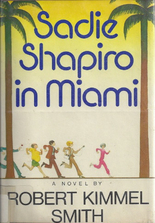
To read this novel is to also travel back to pre-Mariel boat lift Miami Beach, when Jewish snowbirds crowded the buildings along Collins Avenue and Ocean Drive, enjoying the tropical locale in their sunset years. Restaurants served tongue sandwiches on seeded rye bread, chocolate babke coffee cake, and pickled green tomatoes. Patrons dressed in wide bell-bottom pants and macramé vests. My tattered copy borrowed from the Miami Dade Public Library feels its age. The amusing cover shows snowy-haired Sadie in her trademark pink jogging suit being pursued by a female reporter, chased by a man in a suit, pursued by a pot-bellied, balding vacationer, chased by another man in a suit with some kind of legal document, followed by a construction worker. Two towering palm trees, under a yellow sky frame the scene.
When Sadie and Sam relocate to Miami Beach, Smith deftly portrays that competition among sunshine-starved northerners to soak up the rays: No sooner had Sam settled back than he heard the sound of footsteps approaching. A shadow crossed his face. Sam looked up to see a small man staring at him. The man’s skin was pink, and healthy-looking, and a halo of white hair framed his bald pink scalp. The fellow, who could be no more than five feet tall, shook his head. “Fifty empty chairs and you have to sit yourself down in mine,” he grumbled. Characters in the beach-front building include a 72-year-old tap dancer, a pair of Serbo-Croatian exiles who try to win sympathy for their cause and a “whole mishpocha of Sadie’s contemporaries.”
It’s also an era of growing feminism, and the book includes a female journalist who weigh the importance of career versus marriage. Sadie is appreciated for her skills and attributes and experience even in a time when people, but most especially women, are ashamed of their age and aging. Sadie does not dye her hair but she eats right, jogs daily, and always dresses smartly.
When she’s called in for questioning in her role in the scam, Sadie is made to wait. “I knew I should have brought my knitting,” she says. But Sadie isn’t just a joke. She’s a practical problem solver.
To understand Sadie Shapiro, it might be best to read the novel as part of the 70s wave of feminist fiction. The book was published three years after Erica Jong’s novel of sexual adventure and discovery, Fear of Flying, and one year after Gail Parent’s story of a frustrated single woman, Sheila Levine is Dead and Living in New York. Of course, unlike Jong and Parent’s protagonists, Sadie has been through life already, which could lead her to be invisible but instead has helped her be certain of who she is. The status she has reached as a valued celebrity is based on her amazing crafting and problem-solving skills. Forty years after the first Sadie Shapiro book was written, we still chuckle, but we also think, because we are still so far from appreciating people for who they are and celebrating the real heroes. For all its laughs, Sadie Shapiro in Miami has an underlying message of doing right, being true to yourself, and the value of the elderly—and women. 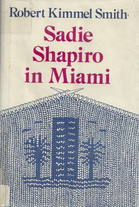
Also mentioned in this review:
Sadie Shapiro’s Knitting Book by Robert Kimmel Smith, Simon and Schuster, 1973. Sadie Shapiro, Matchmaker by Robert Kimmel Smith, Simon and Schuster, 1979. Robert Kimmel Smith's website includes information about his books for children and adults. Dina Weinstein is an award-winning journalist. A graduate of Columbia University Graduate School of Journalism, she has reported for The Trentonian, The Cape Cod Times, and WDIY-FM and has taught journalism and mass communications at a number of colleges including Miami Dade College. Weinstein is advisor for The Reporter, the student newspaper at Miami Dade College. |
